Chapter 18.08
DEFINITIONS
Sections:
18.08.010 General.
The definitions contained in this chapter shall be observed and applied in the interpretation of all chapters in this title, except where the context clearly indicates otherwise. Words used in the present tense shall include the future; words used in the singular number shall include the plural and the plural the singular; words used in the masculine gender shall include the feminine. [Ord. 1746-2023; Ord. 1286-2008. UDO § 11.01.]
18.08.020 A definitions.
“Abandoned” means the relinquishment of property or a cessation of the use of the property for a continuous period of one year by the owner with the intention neither of transferring rights to the property to another owner nor of resuming the use of the property.
“Above-ground utility facility” means permanently located and installed electrical generators, pipeline pumping stations, public wells, telephone exchanges, utility substations, and the like.
Access Street. See “Street, access.”
“Accessory dwelling (or dwelling unit)” means a dwelling subordinate to a primary dwelling on the same lot. This use is typically referred to as a “granny flat” or “in-law apartment” and is generally a detached structure; however, it may be considered an attached addition to the primary structure under certain circumstances.
“Accessory structure” means any structure which:
(1) Is subordinate to a primary structure in area, intent, and/or purpose;
(2) Contributes to the comfort, convenience, or necessity of occupants of the primary structure or primary use;
(3) Does not alter or change the character of the premises;
(4) Is located on the same lot as the primary structure or use; and
(5) Is not designed for human occupancy as a dwelling or commercial use.
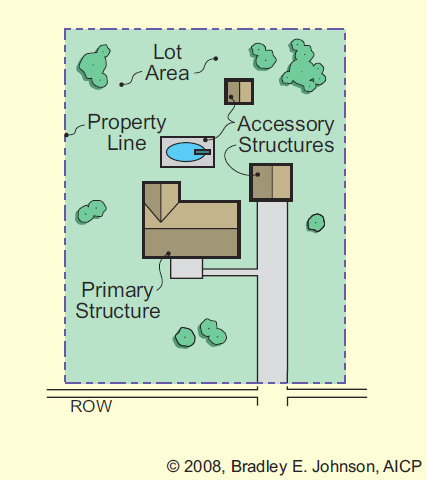
“Accessory structure, recreation-based” means an accessory structure placed on a lot and used for recreation, entertainment and lounging. Examples of recreation-based accessory structures include decks, docks, gazebos, hot tubs, ground-mounted satellite dishes, piers, sport courts, and swimming pools.
“Accessory structure, storage-based” means an accessory structure placed on a lot and used to store, keep, shelter or contain material items. Examples of storage-based accessory structures include barns, boat houses, carports, detached garages, greenhouses, mini-barns, pole structures, pool houses, and sheds.
“Accessory structure, support-based” means an accessory structure placed on a lot and used to provide essential services to a primary structure, primary land use, or another accessory structure. Examples of support-based accessory structures include maintenance facility, mechanical structure, freestanding canopy, standalone restroom facilities, storage building, enclosed vending, kiosk, or structures used in support of the primary structure.
“ADA” means the Americans with Disabilities Act.
“Adjacent property” means any property adjacent to or directly diagonal to the subject property. Properties across a public right-of-way (ROW) are also considered adjacent. The illustration below notes the properties that would be considered adjacent to two different subject properties.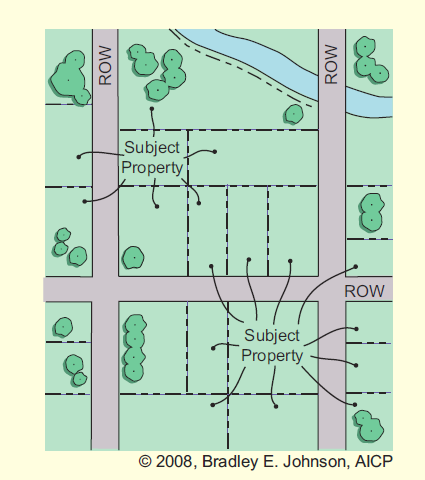
“Administration building” means a structure used by leadership, management or government of a large institution such as a college or university for offices and operations.
Administrative Subdivision. See “Subdivision, administrative.”
Administrator. See “Zoning Administrator.”
“Adult bookstore or adult video store” means a commercial establishment which, as one of its principal business activities, offers for sale or rental for any form of consideration any one or more of the following: books, magazines, periodicals or other printed matter, or photographs, films, motion pictures, video cassettes, compact discs, digital video discs, slides, or other visual representations which are characterized by their emphasis upon the display of specified sexual activities or specified anatomical areas. A “principal business activity” exists where the commercial establishment meets any one or more of the following criteria:
(1) At least 35 percent of the establishment’s displayed merchandise consists of said items; or
(2) At least 35 percent of the retail value (defined as the price charged to customers) of the establishment’s displayed merchandise consists of said items; or
(3) At least 35 percent of the establishment’s revenues derive from the sale or rental, for any form of consideration, of said items; or
(4) The establishment maintains at least 35 percent of its floor space for the display, sale, and/or rental of said items (aisles and walkways used to access said items shall be included in “floor space” maintained for the display, sale, or rental of said items); or
(5) The establishment maintains at least 500 square feet of its floor space for the display, sale, and/or rental of said items (aisles and walkways used to access said items shall be included in “floor space” maintained for the display, sale, or rental of said items); or
(6) The establishment regularly offers for sale or rental at least 2,000 of said items; or
(7) The establishment regularly features said items and regularly advertises itself or holds itself out, in any medium, by using “adult,” “adults-only,” “XXX,” “sex,” “erotic,” or substantially similar language, as an establishment that caters to adult sexual interests; or
(8) The establishment maintains an “adult arcade,” which means any place to which the public is permitted or invited wherein coin-operated or slug-operated or electronically, electrically, or mechanically controlled still or motion picture machines, projectors, or other image-producing devices are regularly maintained to show images to five or fewer persons per machine at any one time, and where the images so displayed are characterized by their emphasis upon matter exhibiting specified sexual activities or specified anatomical areas.
“Adult cabaret” means a nightclub, bar, juice bar, restaurant, bottle club, or similar commercial establishment that regularly features live conduct characterized by semi-nudity. No establishment shall avoid classification as an adult cabaret by offering or featuring nudity.
“Adult motion picture theater” means a commercial establishment where films, motion pictures, videocassettes, slides, or similar photographic reproductions which are characterized by their emphasis upon the display of specified sexual activities or specified anatomical areas are regularly shown to more than five persons for any form of consideration.
Advisory Plan Commission. See “Plan Commission.”
“Agricultural crop production” means a series of activities that result in the growth of grass or crop production.
“Agricultural district” refers to the AG and AC districts.
“Agricultural tourism” means the permanent or temporary uses integrated with an agricultural operation offering agriculture education, agricultural experiences, agricultural products heavily grown or produced on site, and the like. Examples include “you-pick” produce, pumpkin festival, cider mill, observing a dairy operation, retail sales of cheese produced on site, and feeding farm animals. Agricultural tourism shall not include private or commercial stables.
“Agriculture” means the use of land for agriculture purposes, including farming, dairying, pasturage, apiculture, agriculture, horticulture, floriculture, viticulture, and animal and poultry husbandry, and the necessary accessory uses for packing, treating, or storing the produce; provided, however, that the operation of any accessory uses shall be secondary to that of the normal agricultural activities. “Agriculture” does not include feed lots, stock yards, or the commercial feeding of garbage or offal to swine or other animals.
“Airport” means any area which is used or intended to be used for the taking off and landing of aircraft, including helicopters, and any appurtenant areas which are used or intended to be used for airport structures or facilities, including open spaces, taxiways, and tie-down areas.
“Alley” means a public right-of-way, other than a street, crosswalk, or easement, that provides secondary access for the special accommodation of abutting property.
“Amusement park” means a commercial enterprise with three or more of the following: rides (e.g., roller coasters), entertainment, experiences, attractions, performances, and/or themed experiences. Ancillary to the core components listed in the previous sentence are lodging, restaurants, vending, shopping and personal services. Generally, amusement parks are family oriented enterprises and accommodate very large assembly of persons.
“Antenna” means a device for directional or nondirectional sending or receiving of electromagnetic waves (e.g., radio waves).
“Applicant” means the owner, owners, subdivider, developer, or legal representative of real estate who makes application to the Zoning Administrator, Plan Commission, and/or Board of Zoning Appeals for action by the Zoning Administrator, Plan Commission, Board of Zoning Appeals or Common Council affecting the real estate owned or represented by the applicant.
Arterial Street. See “Street, arterial.”
“Assisted living facility” means a residential facility where assistance with daily activities, such as taking medicine, dressing, grooming, and bathing, are provided for the aged or infirm, or any other reasonably independent person in need of nursing care; and which does not contain equipment for surgical care or for treatment of disease or injury, and is not primarily designed for patients being treated for mental illness or alcohol or drug addiction. Assisted living facilities have private rooms that are not shared by non-related persons.
ATM. See “Automated teller machine.”
“Attached structure” means a structure that is structurally connected to another structure by a foundation, wall, bridge, or roof line, or appears to be connected.
“Automated teller machine” (“ATM”) means an electronically operated device used to conduct financial transactions on site, by means of direct computerized access.
“Automobile car wash” means a structure, or portion of a structure, containing facilities for washing one or more automobiles at any one time, using production line methods such as a chain conveyor, blower, steam cleaning device, or other mechanical devices; or providing space, water, equipment, or soap for the complete or partial cleaning of such automobiles, whether by operator or by customer.
“Automobile gas station” means any land, building, structure, or premises used for the retail sale of motor vehicle fuels, oils, or accessories.
“Automobile rental” means any land, building, structure, or premises used for the operation of renting motor vehicles on a temporary basis and including any incidental storage thereof.
“Automobile repair/body shop” means any land, building, structure, or premises used for the general repair of automobiles including but not limited to engine rebuilding or reconditioning of motor vehicles; engine steam cleaning; transmission welding or rebuilding and installation; automobile accessory installation or repair; collision service such as body, frame and fender straightening and repair; and painting of motor vehicles. Automobile repair/body shop may also include automobile services, as defined, as a secondary service.
“Automobile sales” means any land, building, structure, or premises used for the sale or lease of new or used motor vehicles. Automobile sales may include automobile repair/body shop and automobile service, as defined, as a secondary service.
“Automobile services” means any land, building, structure, or premises used for the routine maintenance of automobiles, and limited servicing of automobiles including but not limited to the sale and installation of oil, lubricants, filters, batteries, tires, brakes, belts, and other similar activities or for installing or repairing parts and accessories but not to include the activities of automobile repair/body shop, as defined.
Average Setback. See “Setback, average.” [Ord. 1746-2023; Ord. 1425-2012 § 5; Ord. 1286-2008. UDO § 11.02.]
18.08.030 B definitions.
Base Zoning District. See “Underlying zoning district.”
“Basement” means that portion of a structure below the first or ground floor level and having less than four feet of clearance from its ceiling to the average finished grade of the structure perimeter. A basement shall not be considered a story for the purposes of determining structure height, except when it is used or suitable for habitation.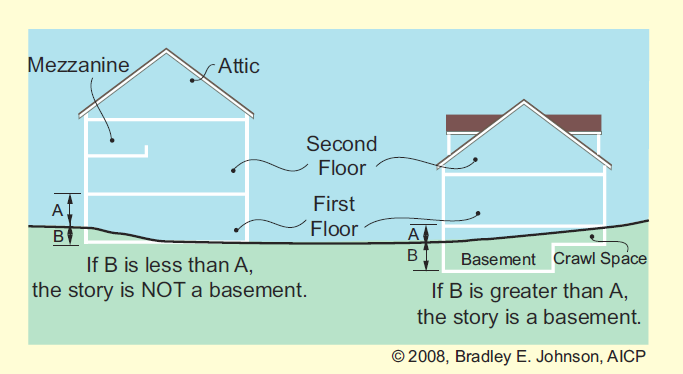
“Bed and breakfast facility” means an owner-occupied or employee-of-the-owner-occupied property containing no more than six guest rooms for hire, for lodging by prearrangement for periods not to exceed three consecutive weeks and providing daily meals (at least breakfast) to guests as part of the fee. The term does not included hotels, motels, boarding houses, or food service establishments.
“Berm” means a manmade, formed, earth mound of definite height and width used for landscaping and screening purposes, the intent of which is to provide a transition between uses of differing intensity or to screen uses from sight.
“Block” means property abutting on one side of a street and lying between the two nearest intersecting or intercepting streets, intersecting railroad, intersecting waterway, or the end of a dead end street.
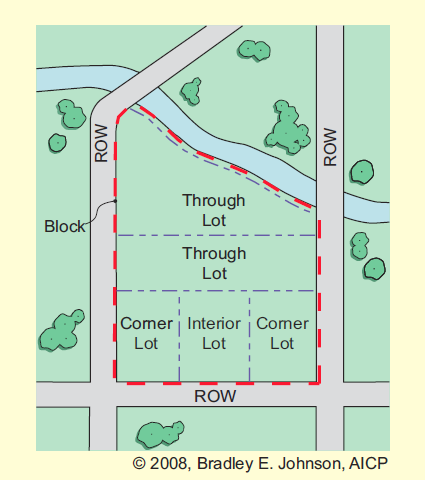
Board. See “Board of Zoning Appeals.”
“Board of Zoning Appeals” means the City of Angola Board of Zoning Appeals or any division thereof.
“Boarding house” means a structure in which lodging and meals are regularly provided for compensation for at least three but not more than 10 persons.
Broadcast Studio. See “Radio or TV station.”
“Buffer landscaping” means any trees, shrubs, walls, fences, berms, space, or related landscaping features required under this title for buffering lots from adjacent properties or public rights-of-way for the purpose of increasing visual shielding or other aspects of privacy and/or aesthetics.
“Buffer yard” means an area adjacent to front, side, and rear property lines, measured perpendicularly from adjacent property lines and/or right-of-way lines, intended to provide attractive spaces to reduce the impacts of proposed uses on adjacent property or natural features and to screen incompatible uses from each other and from the right-of-way. Buffer yards also help to maintain existing trees or natural vegetation, to block or reduce noise, glare or other emissions and to maintain privacy. Buffer yards are in addition to (separate from) front, rear, or side yard setbacks.
Buildable Lot. See “Lot, improved.”
“Building” means a structure having a roof, supported by columns or walls, for the shelter, support, or enclosure of persons, property, or animals; and when separated by division walls from the ground up and without openings, each portion of such building shall be deemed as a separate building.
“Building area” means the horizontal area of the buildings on a lot, measured from the outside exterior walls, excluding open areas or terraces, unenclosed porches or decks, and architectural features that project no more than two feet.
“Building code” means the Indiana Building Code which establishes and controls the standards for constructing all forms of permanent structures and related matters.
Building, Detached. See “Detached structure.”
“Building envelope” means the setback lines that establish an area on a lot in which building can occur.
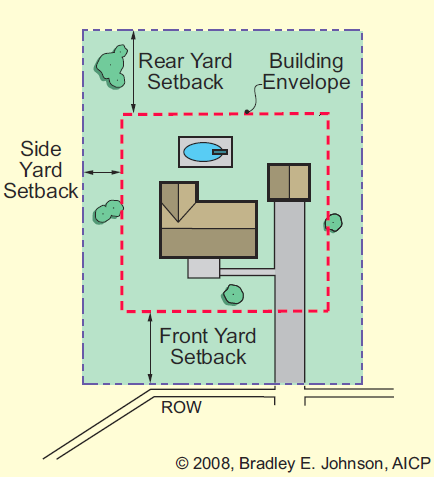
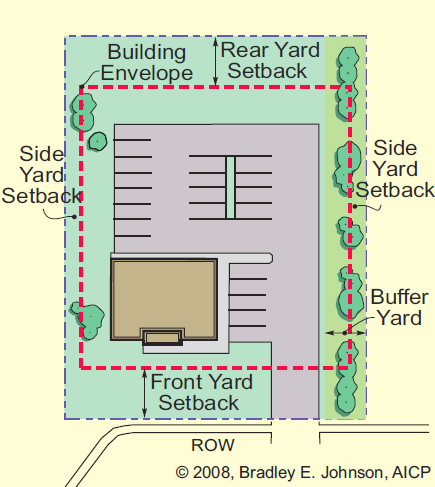
Building Height. See “Structure height.”
“Building, multiple-tenant” means a building that contains more than one business, organization and/or institution.
“Building, single-tenant” means a building that contains only one business, organization and/or institution.
“Bumpout” means an extension of a street curb toward the centerline of a street creating a narrowed street, either for the purpose of defining parking spaces, shortening a crosswalk, adding landscaping area along a street, or the like.
“Business” means the engaging in the purchase, sale, barter, or exchange of goods, wares, merchandise, or services, or the maintenance or operation of office, recreational, or amusement enterprises.
BZA. See “Board of Zoning Appeals.” [Ord. 1746-2023; Ord. 1286-2008. UDO § 11.02.]
18.08.040 C definitions.
“Campground” means any site, lot, field, or tract of land designed with facilities for short-term occupancy by recreational vehicles and other camping equipment but not including mobile homes. A campground facility will include common facilities for users, such as restrooms, electricity, dumping stations, and water stations.
“Canopy tree” means deciduous trees that grow to at least 40 feet in height and have a canopy that is round or oval in shape. Conical or tubular shaped trees are not canopy trees.
“Cellular communication equipment” means antennas and other transmitting and/or receiving devices or other associated devices used in the provision of telecommunications service.
“Cemetery” means property used for interring of the dead, inclusive of any crematory, mausoleum or mortuary operated in conjunction with and on the same property.
“Central sewer system” means a community sewer system including collection and treatment facilities owned and maintained by the City of Angola.
“Central water system” means a community water supply system including existing and new wells and/or surface water sources and intakes, treatment facilities, and distribution lines and includes such of the above facilities established by the developer to serve a new subdivision, or commercial or industrial development.
“Certificate of completion” means a certificate stating that an improvement previously approved by the Zoning Administrator, Plan Commission, or Board of Zoning Appeals complies with all pertinent requirements of this title or commitments placed by the Plan Commission and/or Board of Zoning Appeals and therefore may be used or occupied.
“Certificate of occupancy” means a certificate stating that the occupancy and use of a structure complies with all applicable provisions of this title and the Indiana Building Code.
Changeable Copy. See “Sign, changeable copy.”
Changeable Copy, Electronic. See “Sign, electronic changeable copy.”
Changeable Copy, Manual. See “Sign, manual changeable copy.”
“Characterized by” means describing the essential character or quality of an item. As applied in this title, no business shall be classified as a sexually oriented business by virtue of showing, selling, or renting materials rated NC-17 or R by the Motion Picture Association of America.
“Child care center” means any institution operated for the care of children, regulated by IC 12-17.2 et seq., and as defined by IC 12-7-2-28.2.
“Child care home” means, as defined by IC 12-7-2-28.6 and for the purpose of this title, a residential structure in which at least six children (not including the children for whom the provider is parent, stepparent, guardian, custodian, or other relative or any child who is at least 14 years of age and does not require child care) at any time receive child care from a provider: (1) while unattended by a parent, legal guardian, or custodian; (2) for regular compensation; and (3) for more than four hours but less than 24 hours in each of 10 consecutive days per year, excluding intervening Saturdays, Sundays, and holidays. The term includes class I child care home and class II child care home as defined in IC 12-7-2-33.7 and 12-7-2-33.8.
“Child care institution” means, as defined by IC 12-7-2-29 and for the purpose of this title, an institution that:
(1) Operates under a license under IC 31-27;
(2) Provides for delivery of mental health services that are appropriate to the needs of the individual; and
(3) Complies with the rules adopted under IC 4-22-2 by the Department of Child Services.
Children’s Home. See “Child care institution.”
Church. See “Places of worship.”
“City” means City of Angola, Indiana.
“City official” means a member of the Common Council, Board of Public Works and Safety, Plan Commission, Plan Commission staff, Board of Zoning Appeals, or an employee of the city.
“Classroom” means a space used by a teacher, professor or instructor to educate or train students.
“Clinic” means an establishment in which human patients are admitted for medical or dental study or treatment and in which the services of physicians or dentists are provided.
“Club house” means a structure used in association with a recreational facility, such as a golf course, in which there may be locker rooms, administration offices, facility storage and maintenance, rest rooms, lounges, meeting space, snack bar, banquet facilities, and retail sales of golf related products.
“Club or lodge” means the meeting place of a branch of an organization of persons for some common object jointly supported and meeting periodically.
“Collocation” means a space on an existing or proposed telecommunication tower that can be used for the installation and/or mounting of antennas or radio or cellular communication equipment that operates on a different frequency from the initial user.
“Commercial districts” refers to the NC, DC, C1, C2, and HC districts.
“Commercial training facility” means a site used for education and preparation of individuals in a specific field or skill. May include indoor or outdoor spaces and may be manipulated to create different drills or activities for hands-on demonstrations.
“Commercial wireless communications service” means a licensed commercial wireless telecommunications service, including cellular, personal communication services (PCS), specialized mobile radio (SMR), enhanced specialized mobile radio (ESMR), paging, and similar devices that are marketed to the general public.
Commission. See “Plan Commission.”
“Commitment” means a recordable written agreement or covenant concerning the use or development of a parcel or real property which is made in writing by the owner of that parcel that may include a site plan and/or other pertinent drawings that set forth any binding limitations of use or development for that particular parcel. This may be made either voluntarily or in accordance with an order or request of the Plan Commission or Board of Zoning Appeals.
“Comprehensive Plan” refers to the Angola Comprehensive Plan. The plan includes goals, objectives, and implementation measures for land use, growth management, transportation, public services, the environment, image and identity, economic development, parks and recreation, and inter-jurisdictional cooperation. The Comprehensive Plan was developed and adopted by the Plan Commission pursuant to IC 36-7-4-500 et seq. and includes any part and/or policies separately adopted and any amendment to the plan and/or the policies.
“Condition of approval” means stipulations or provisions set forth by any governmental entity, including Board of Zoning Appeals and Plan Commission, required as a prerequisite for approval of a petition.
“Condominium” means real estate lawfully subject to IC 32-25 et seq. (the Condominium Law), by the recording of condominium instruments, in which undivided interests in the common areas and facilities are vested in the condominium unit owners.
“Confined feeding” means the raising of animals for food, fur, or recreation in lots, pens, ponds, sheds, or buildings, where they are confined, fed, and maintained for at least 45 days during any year, and where there is no ground cover or vegetation present over at least half of the animals’ confinement area.
“Confined feeding operation (large)” means any livestock operation engaged in the confined feeding of at least 1,000 cattle, or 1,000 swine, or 10,000 sheep, or 30,000 hens or ducks. All thresholds are defined by the Indiana Department of Environmental Management (IDEM).
“Confined feeding operation (medium)” means any livestock operation engaged in the confined feeding of between 300 and 999 cattle, or 750 and 999 swine, or 3,000 and 9,999 sheep, or 9,000 and 29,999 hens, or 10,000 and 29,999 ducks. All thresholds are defined by the Indiana Department of Environmental Management (IDEM).
“Confined feeding operation (small)” means any livestock operation engaged in the confined feeding of less than 300 cattle, or 750 swine, or 3,000 sheep, or 9,000 hens or 10,000 ducks. All thresholds are defined by the Indiana Department of Environmental Management (IDEM).
“Construction plan(s)” means the maps or drawings showing the specific location and design of improvements to be installed in accordance with the requirements of this title and the Indiana Building Code as a condition of approval.
“Continuous mound” means a landscape feature used for screening in which a continuous raised section of earth is used to block or partially block visibility from one side to the other. In particular, continuous mounds are linear with a top elevation (crest) relatively consistent from one end to the other.
Corner Lot. See “Lot, corner.”
“County” means Steuben County, Indiana.
“Covenants” means private and legal restrictions of various kinds on the usage of lots, typically within a subdivision and applied by the subdivider. In the case of public health, safety, and welfare, covenants may be applied by the Plan Commission that are recorded with the plat and deed. Covenants can also be placed on commercial and industrial developments. Unless specifically agreed to, covenants are not enforceable by the Plan Commission. However, they are enforceable in civil court by interested or affected parties.
“Cul-de-sac” means a street having one end open to traffic and being permanently terminated by a vehicular turnaround at the other end.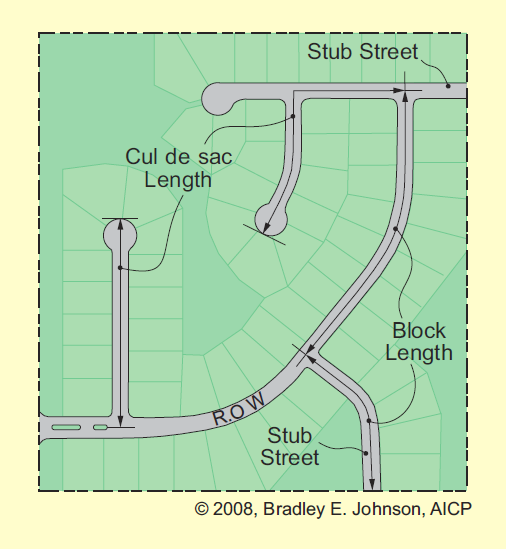
Cyclical Message. See “Sign, cyclical message.” [Ord. 1746-2023; Ord. 1425-2012 §§ 5, 6; Ord. 1325-2010; Ord. 1286-2008. UDO § 11.02.]
18.08.050 D definitions.
“Dance or night club” means an establishment for entertainment with table seating, stage (or area) for disc jockeys, musical performances and floor area designated for dancing.
“Day care, adult” means any institution operated for the care of adults facing disabilities as regulated under IC 12-10 et seq.
Day Care Center. See “Child care center.”
DBH. Diameter at breast height is a tree trunk diameter measured in inches at a height of four and one-half feet above the ground. If a tree splits into multiple trunks below four and one-half feet, the trunk is measured at its most narrow point beneath the split.
“Deck” means an accessory structure which is on the ground or is elevated from ground level and is open to the sky.
“Dedication” means the setting apart of land or interests in land for use by the municipality or public by ordinance, resolution, or entry in the official minutes as by the recording of a plat.
“Demolition” means the complete removal or destruction of any structure excluding its foundation.
“Designed fail area” means the area surrounding a tower in which the tower could fall should it fail as structurally designed. The designed fail area is quantified in terms of linear distance from the tower to the perimeter of the designed fail area. The designed fail area shall be certified by a structural engineer.
Detached Building. See “Detached structure.”
“Detached structure” means a structure that has no structural connection with the primary structure or any other building or structure.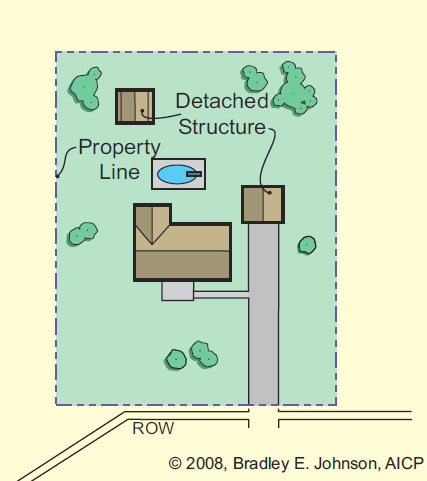
Developed Lot. See “Lot, developed.”
“Developer” means the owner or legal representative of land proposed to be subdivided or used for agricultural, residential, commercial, institutional, mixed used, industrial or the like purposes.
“Development” means the act of modifying a lot, parcel or property developing as a plan or method, or an image upon a photographic plate; gradual advancement or growth through a series of progressive changes; also, the result of developing, or a developed state.
“Development standards” means height, bulk, density, environmental performance standards, and other standards for development as set forth in this title, including landscaping, parking, and other required improvements, excluding those provisions which specifically regulate the use, per se, of property.
Development Standards Variance. See “Variance, development standards.”
Diameter at Breast Height. See “DBH.”
“Dining hall” means a structure used primarily to provide food services to students and associated with a college or university.
District. See “Zoning district.”
“District intent” means a zoning district’s purpose to ensure that all development is consistent with goals, objectives, and policies identified in the comprehensive plan. This acts as a guideline, not a law.
“DNR” means Indiana Department of Natural Resources.
“Domestic pets” means animals commonly used as household pets, protection, companions, and for assistance to disabled persons. “Domestic pets” shall include animals that are cared for and treated in a manner acceptable for pet dogs, cats, and birds. “Domestic pets” shall include, but not be limited to, dogs, cats, parakeets, parrots, finches, lizards, spiders, guinea pigs, hamsters, gerbils, rats, mice, rabbits, aquarium fish, ferrets, and snakes if cared for in the manner described above.
Dormitory. See “Residence hall.”
Drive, Private. See “Street, access.”
“Drive-through establishment” means a place of business, being operated for the sale and purchase at retail of food and other goods, services, or entertainment, which is laid out and equipped so as to allow its patrons to be served or accommodated while remaining in their automobiles.
“Driveway” means any facility or structure used to convey vehicles to public streets.
Duplex. See “Dwelling, single-family attached.”
“Dwelling” means a structure, or portion thereof, conforming to all requirements applicable to the district in which it is located, all building codes, and that is used exclusively for residential occupancy, including single-family dwelling units, two-family dwelling units, and multiple-family dwelling units, but excluding hotels, motels, and boarding houses.
Dwelling, HUD. See “Dwelling, mobile home.”
“Dwelling, manufactured home” means a single-family dwelling unit designed and built in a factory, installed as a permanent residence, which bears a seal certifying that it was built in compliance with the federal Manufactured Housing Construction and Safety Standards Law (1974 U.S.C. Section 5401 et seq.), and which also complies with the following specifications:
(1) Was constructed after January 1, 1981, and exceeds 950 square feet of occupiable space per IC 36-7-4(d);
(2) Is attached to a permanent foundation of masonry construction and has a permanent concrete or concrete block perimeter enclosure constructed in accordance with the One- and Two-Family Dwelling Code;
(3) Has wheels, axles, and towing chassis removed;
(4) Has a pitched roof with a minimum rise of 2:12; and
(5) Consists of two or more sections which, when joined, have a minimum dimension of 23 feet in width for at least 60 percent of its length.
“Dwelling, mobile home” means a transportable dwelling unit which is a minimum of eight feet in width and which is built on a permanent foundation or tied down with perimeter skirting when connected to the required utilities, and includes the plumbing, heating, air conditioning, and electrical system contained therein, and which was manufactured either:
(1) Prior to June 15, 1976, and bears a seal attached under Indiana Public Law 135, 1971, certifying that it was built in compliance with the standards established by the Indiana Administrative Building Council; or
(2) Subsequent to or on June 15, 1976, and bears a seal certifying that it was built in compliance with the federal Mobile Home Construction and Safety Standards.
“Dwelling, modular home” means a dwelling unit designed and built in a factory that meets state and local building codes. A modular home is installed and assembled as a permanent residence on a permanent foundation.
“Dwelling, multiple-family” means a residential structure designed to be occupied by four or more families, with the number of families in residence not exceeding the number of dwelling units provided.
Dwelling, Single-Family. See “Dwelling, single-family detached” or “Dwelling, single-family attached.”
“Dwelling, single-family attached” means an attached residential dwelling unit designed to be occupied by two or three families, with the number of families in residence not exceeding the number of dwelling units provided. This is commonly referred to as duplex or triplex.
“Dwelling, single-family detached” means a detached residential dwelling unit designed to be occupied by one family.
“Dwelling site” means a site within a manufactured home park and/or mobile home park with required improvements and utilities that is leased for the long-term placement of a manufactured home and/or mobile home.
“Dwelling size” means the overall square footage of a dwelling unit. The dwelling size does not include a garage, carport, deck, unfinished storage, patio or open porch.
Dwelling, Two-Family. See “Dwelling, single-family attached.”
“Dwelling unit” means a single unit for owner occupancy or for rent or lease, physically separated from any other dwelling units which may be in the same structure, and providing complete and independent living facilities for one or more persons, including permanent provisions for living, sleeping, cooking, and sanitation. Examples of a dwelling unit include a single-family dwelling, multiple-family dwelling, mobile home dwelling, manufactured home dwelling, and farmstead.
“Dwelling unit (upper floor)” means any housing that is attached to or contained within the same building as commercial property, generally located above a storefront. The address of an upper floor dwelling unit shall derive from the primary entrance in which the unit is accessed. [Ord. 1746-2023; Ord. 1286-2008. UDO § 11.02.]
18.08.060 E definitions.
“Easement” means a grant by a property owner (“grantor”) to specific persons, the general public, corporations, utilities, or others (“grantee” or “easement holder”) for the purpose of providing services or access to the property.
“Electrical generation plant” means a facility designed to produce electric energy from another form of energy, such as: heat (thermal) energy (fossil fuels, solar thermal, geothermal, nuclear); hydroelectricity; wind energy; solar energy.
Electronic Changeable Copy. See “Sign, electronic changeable copy.”
“Elevated structure” means a structure built to have the lowest floor elevated above the ground level by means of fill, solid foundation perimeter walls, pilings, or columns (posts and piers).
“EPA” means United States Environmental Protection Agency.
“Erosion” means the wearing away of the land surface by water, wind, ice, gravity, or other geological agents.
Established Building Setback Line. See “Setback, established.”
“Event center” means a structure available to the public for community activities, meetings, banquets, projects, gatherings, and the like. An event center may be able to be reserved by the public for private parties and functions. An event center includes banquet halls, community centers, and the like.
“Exotic animals” means animals not normally considered to be household pets or farm animals and which may or may not be potentially dangerous.
“Expressway” means any street that operates at a high service level, consists of limited access, is divided, carries region-wide traffic and is generally classified as part of the interstate system.
“Eyebrow” means a semicircular extension of a curb on one side of a street designed to provide more street frontage for a small number of lots. [Ord. 1746-2023; Ord. 1352-2010; Ord. 1286-2008. UDO § 11.02.]
18.08.070 F definitions.
“FAA” means Federal Aviation Administration.
Fair Housing Facility (Large). To prevent the discrimination of mentally or physically disabled persons, these facilities have been identified as types of housing that are permitted in certain districts, but still must meet nondiscriminatory health, fire, safety, and building regulations. These facilities include:
(1) Group homes for children in need of service under IC 31-34-1 or children who have committed a delinquent act under IC 31-37-2-2, 31-37-2-3, or 31-37-2-5; and specifically a facility that houses more than 10 children.
(2) Residential facility for the developmentally disabled which provides residential services for more than eight developmentally disabled individuals as described in IC 12-28-4.
Fair Housing Facility (Small). To prevent the discrimination of mentally or physically disabled persons, these facilities have been identified as types of housing that are permitted in any single-family or multiple-family residential zoning district, but still must meet nondiscriminatory health, fire, safety, and building regulations. These facilities include:
(1) Group homes for children in need of service under IC 31-34-1 or children who have committed a delinquent act under IC 31-37-2-2, 31-37-2-3, or 31-37-2-5; and specifically a facility that houses not more than 10 children.
(2) Residential facility for the developmentally disabled which provides residential services for eight developmentally disabled individuals or less as described in IC 12-28-4.
(3) Residential facility for the mentally ill which provides residential services for mentally ill individuals as described in IC 12-28-4. No two residential facilities for the mentally ill shall be within 3,000 feet of one another in the planning jurisdiction as stated in Indiana Code.
“Family” means an individual; or two or more persons related by blood, marriage, or adoption; or a group of not more than three persons, not related by blood, marriage or adoption, living together as a single housekeeping unit in a dwelling unit.
“Farmer’s market” means the assembly of local producers and providers of fruit, vegetables, meat, bread, dairy, herbs, spices, eggs, wine, and other products of local and regional farms; at an interior or exterior location for the public to purchase such products. Ancillary to farm products, non-farm products and products manufactured from farm products may be sold.
“FCC” means United States Federal Communications Commission.
“FEMA” means United States Federal Emergency Management Agency.
“Fence” means a vertical structure, solid or otherwise, used for containment, security, aesthetics, a landscape feature, and the like. Fences are inclusive of permanently affixed structures, temporarily affixed structures, and living material (a dense hedge row).
Financial Services Office. See “Office, financial services.”
“Fixture, cutoff” means a luminaire that:
(1) Projects at least 90 percent of the total lamp lumens below 80 degrees from vertical;
(2) Does not allow more than 10 percent of the total lamp lumens above 80 degrees from vertical; and
(3) Does not allow more than two and one-half percent of the total lamp lumens above 90 degrees from vertical.
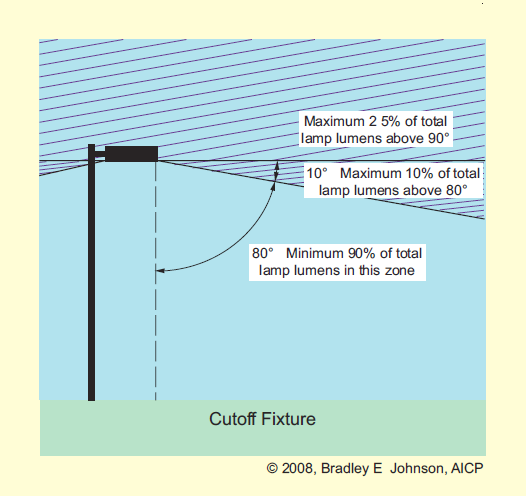
“Fixture, full-cutoff” means a luminaire that:
(1) Projects at least 90 percent of the total lamp lumens below 80 degrees from vertical;
(2) Does not allow more than 10 percent of the total lamp lumens above 80 degrees from vertical; and
(3) Does not allow any lamp lumens above 90 degrees from vertical.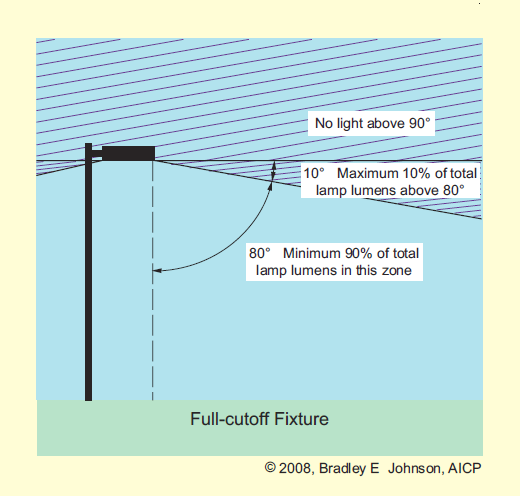
“Fixture, non-cutoff” means a luminaire with no control of the horizontal distribution of luminance.
“Fixture, semi-cutoff” means a luminaire that:
(1) Projects at least 80 percent of the total lamp lumens below 80 degrees from vertical;
(2) Does not allow more than 20 percent of the total lamp lumens above 80 degrees from vertical; and
(3) Does not allow more than five percent of the total lamp lumens above 90 degrees from vertical.
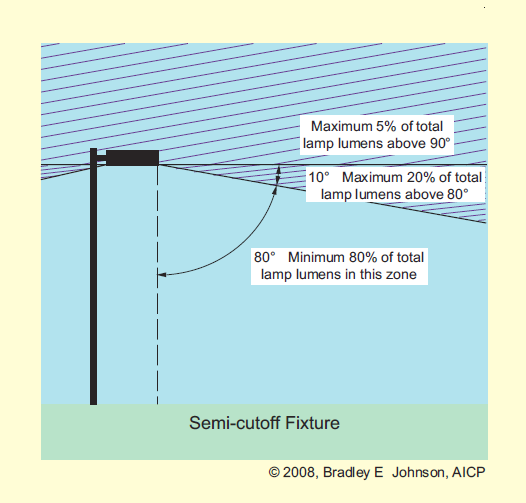
Flashing Message. See “Sign, flashing message.”
“Flex space” means a commercial or industrial building that has been designed to accommodate multiple tenants each able to utilize one or more of the predesigned tenant spaces.
“Flood” means a general and temporary condition of partial or complete inundation of normally dry land areas from the overflow, the unusual and rapid accumulation, or the runoff of surface waters from any source.
“Flood protection grade” (“FPG”) means the elevation of the regulatory flood plus two feet at any given location in the SFHA.
“Floodplain” means the relatively flat area or low land adjoining the channel of a river or stream which has been or may be covered by flood water. The floodplain includes the channel, floodway, and floodway fringe. Floodplain boundaries are to be determined by using the floodway-flood boundary maps of the Federal Insurance Administration or Federal Emergency Management Administration.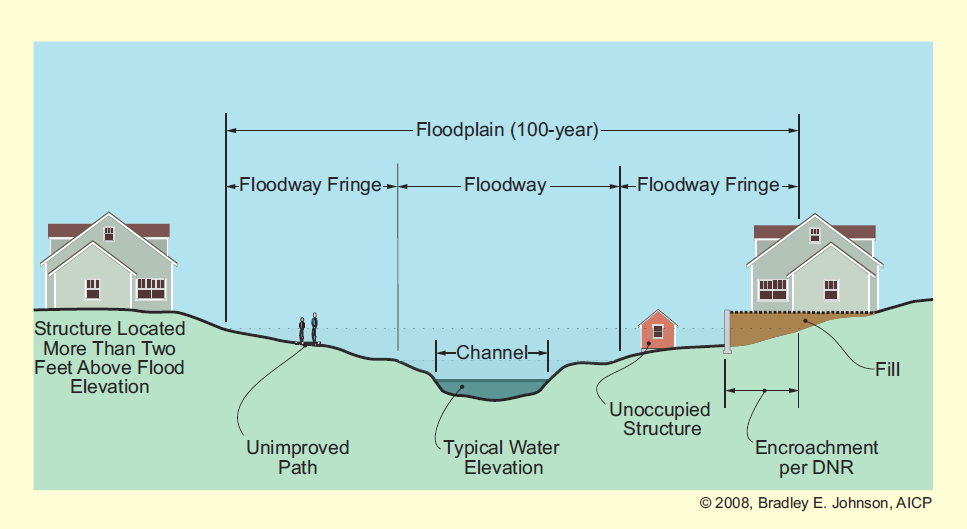
“Floodway fringe” means those portions of the floodplain lying outside the floodway.
“Floodway, regulatory” means the channel of a river or stream and those portions of the floodplains adjoining the channel which are reasonably required to efficiently carry and discharge peak flow of the regulatory flood of any river or stream, and is that area covered by floodwaters in significant downstream motion or covered by significant volumes of stored water during the occurrence of the regulatory flood.
“Floor area” means the sum of all horizontal surface areas of all floors of all roofed portions of a structure enclosed by and within the surrounding exterior walls or roofs, or to the center line(s) of party walls separating such structures or portions thereof. Floor area of a structure shall exclude exterior open balconies and open porches.
“Floor area, main” means that portion of floor area constructed, completed, and usable for living purposes with normal living facilities which includes sleeping, dining, cooking, working, entertainment, common space linking rooms, areas for personal hygiene, or combination of those areas located on the first (or nearest ground level) floor of the structure. The main floor area of a primary structure does not include a garage, carport, deck, unfinished storage, patio, or open porch.
“Floor space” means the floor area inside a sexually oriented business that is visible or accessible to patrons for any reason, excluding restrooms.
“Foundation” means the supporting member of a wall or structure.
Freeway. See “Expressway.”
“Front façade” means the façade of a building that faces the street from which the address to the building is assigned.
“Front line” means, with respect to a structure, the foundation line that is nearest the front lot line.
Front Lot Line. See “Lot line, front.”
Front Yard. See “Yard, front.”
Frontage. See “Lot frontage.”
Frontage Street. See “Street, frontage.” [Ord. 1746-2023; Ord. 1425-2012 § 5; Ord. 1352-2010; Ord. 1286-2008. UDO § 11.02.]
18.08.080 G definitions.
“Garage” means an attached or detached structure whose primary use is to house motor vehicles or personal property for the accommodation of related dwelling units or related business establishments.
General Services Office. See “Office, general services.”
“Geographic information system” (“GIS”) means a computer system that stores and links nongraphic attributes or geographically referenced data with graphic map features to allow a wide range of information processing and display operations, as well as map production, analysis, and modeling.
GIS. See “Geographic information system” (“GIS”).
“Golf course” means an area of terrain on which the game of golf is played during daylight hours. A golf course includes greens, fairways, and natural areas. A golf course may also include a driving range when integrated with the golf course operations and hours.
“Government operation (non-office)” means a facility owned, operated, or occupied by any level of government to provide a governmental service, but not including offices for the provision of government services or facilities for any government facility separately defined in this chapter.
“Grade, finished” means the average elevation of the finished surface of the ground within 10 feet of the structure after final grading.
“Grantee” means a person to whom an interest in property is granted.
“Gross floor area” means the sum of all horizontal floor area of all floors within a structure.
Ground Floor Area. See “Floor area, main.”
“Group home” means a facility that houses not more than 10 children that are either:
(1) In need of service under IC 31-34-1; or
(2) Children who have committed a delinquent act under IC 31-37-2-2, 31-37-2-3 or 31-37-2-5.
Group homes are not subject to covenants, deeds, or other instruments pertaining to the transfer, sale, lease, or use of property that would permit the residential use of property but prohibit the use of that property as a group home as a matter of state public policy reasons. Group homes cannot be prohibited on the grounds that they are a business, the persons living in a group home are not related, or any other reason. All group homes must abide by IC 31-27-5-1 and shall be a licensed facility with the state, meeting fire codes, building codes, and specific group home regulations. [Ord. 1746-2023; Ord. 1286-2008. UDO § 11.02.]
18.08.090 H definitions.
“Habitable space” means any space in a structure suitable for living, sleeping, eating or cooking purposes, excluding such enclosed places as closets, pantries, bath or toilet rooms, hallways, laundries, storage spaces, utility rooms and similar spaces.
“Hardship” means a difficulty with regard to one’s ability to improve land stemming from the application of the development standards of this title, which may or may not be subject to relief by means of variance. In and of themselves, self-imposed situations and claims based on a perceived reduction of or restriction on economic gain shall not be considered hardships. Self-imposed situations include: the purchase of land with actual or constructive knowledge that, for reasons other than physical characteristics of the property, the development standards herein will inhibit the desired improvement; any improvement initiated in violation of the standards of this title; any result of land division requiring variance from the development standards of this title in order to render that site buildable.
Height. See “Structure height.”
“High impact district” refers to the HI district.
“Historic structure” means a building that is recognized for its age or significance, or as a cultural resource. Generally buildings or structures are greater than 50 years in age.
“Hobby farming” means the use of land for purposes including: dairying, pasturage, apiculture, agriculture, horticulture, floriculture, viticulture, and animal and poultry husbandry. Processing and storage of harvested produce or other end products shall not be allowed on site. The hobby farming use(s) shall not exceed 40 percent of the land area of the lot and shall abide by all setback regulations. Hobby farming cannot be the primary income source for the owner, operator or household on site. Hobby farming shall not include feed lots, stock yards, or the commercial feeding of garbage or offal to swine or other animals.
“Home based business, type 1” means a very low impact business being operated out of a residence.
“Home based business, type 2” means a low impact business being operated out of a residence.
“Home based business, type 3” means a moderately intense business being operated from an accessory building on a lot with a residence.
“Hospital” means an institution providing primary health services and medical or surgical care to persons, primarily inpatients, suffering from illness, disease, injury, and other abnormal physical or mental conditions and including, as an integral part of the institution, related facilities, such as laboratories, outpatient facilities, training facilities, medical offices, and staff residences.
“Hotel” means a structure in which temporary lodging or board and lodging are provided and offered to the public for compensation and in which ingress and egress to and from all rooms is made through an inside lobby or office supervised by a person in charge at all hours. As such, it is open to the public. Compensation is usually assessed on a day-to-day basis.
“Hub height” means the distance measured from grade to the central axis of the rotors on a horizontal axis wind turbine. [Ord. 1746-2023; Ord. 1352-2010; Ord. 1286-2008. UDO § 11.02.]
18.08.100 I definitions.
“IAC” means Indiana Administrative Code.
“IC” means Indiana Code.
“IDEM” means Indiana Department of Environmental Management.
“Illuminance” means the total amount of visible light illuminating (incident upon) a point on a surface from all directions above the surface (i.e., how brightly a surface is illuminated). Illuminance is measured in lux or footcandles.
“Impervious surface” means any material that prevents absorption of stormwater into the ground such as concrete or asphalt. This does not include gravel, rock, or stone.
“Impervious surface coverage” means the area of a lot occupied by the primary structure, any accessory structures, and impervious surface.
Improved Lot. See “Lot, improved.”
“Improvement” means any permanent structure that becomes part of, placed upon, or is affixed to real estate, or any alteration to the land.
“Improvement location permit” means a permit issued under this title prior or simultaneously to receiving a building permit, permitting a person, firm, or corporation to erect, construct, enlarge, alter, repair, move, occupy, use, improve, remove, convert, or demolish any structure within its jurisdiction, or permitting a person to change the condition of the land.
“Improvement, off-site” means any premises not located within the area of the property to be subdivided, used, or built upon whether or not in the same ownership of the applicant for subdivision approval.
“Incidental” means a minor occurrence or condition which is customarily associated with a permitted use and is likely to ensue from normal operations.
“Incinerator” means a facility for burning waste material, especially industrial waste, at high temperatures until it is reduced to ash.
“Increased cost of compliance” means the cost to repair a substantially damaged structure that exceeds the minimal repair cost and that is required to bring a substantially damaged structure into compliance with the local floodplain management regulations. Acceptable mitigation measures are elevation, relocation, demolition, or any combination thereof. All renewal and new business flood insurance policies with effective dates on or after June 1, 1997, will include increased cost of coverage.
“INDOT” means Indiana Department of Transportation.
“Industrial district” refers to the I1, I2, and I3 districts.
Industry, Light. See “Manufacturing, light.”
Industry, Heavy. See “Manufacturing, heavy.”
“Initial user” means the applicant, person, organization, or corporation that originally applies to the city for approval for the installation of an antenna or other radio or cellular communication equipment or for approval for the construction of a telecommunication tower or facility.
“Institutional district” refers to the IS district.
Interested Party(ies). See definition listed in the Plan Commission and/or Board of Zoning Appeals Rules and Procedures.
Interior Lot. See “Lot, interior.”
Interstate. See “Expressway.” [Ord. 1746-2023; Ord. 1286-2008. UDO § 11.02.]
18.08.110 J definitions.
“Jail” means a facility operated by a local unit of government used for the confinement of alleged or convicted offenders. In general, a jail facility is intended for short sentences or temporary confinement waiting for a hearing or trial.
“Junk” means an automobile, truck, other motor vehicle, watercraft, large appliances, furniture, tools, disregarded landscape material, or like materials which have been damaged to such an extent that they cannot be operated under their own power or used and/or will require major repairs before being made usable. This also includes such a vehicle which does not comply with state, county, or city vehicle licensing or other laws or ordinances.
“Junkyard” means a place, usually outdoors, where waste or discarded used property, including but not limited to automobiles, farm implements and trucks, is accumulated and is or may be salvaged for reuse or resale. This does not include industrial scrap metal or accumulation of organic matter.
Jurisdiction. See “Planning jurisdiction.”
“Juvenile detention facility” means a facility that holds children or minors (typically under 18 years of age) for punishment and/or counseling as a result of sentencing by a court of jurisdiction for criminal or antisocial behavior. [Ord. 1746-2023; Ord. 1286-2008. UDO § 11.02.]
18.08.120 K definitions.
“Kennel” means a place for keeping adult dogs or other small animals that are ordinarily bred for sale as pets, including temporary care facilities for animals for compensation. [Ord. 1746-2023; Ord. 1286-2008. UDO § 11.02.]
18.08.130 L definitions.
“L90” means a measure that represents the decibel level, using an A-weighting, that is exceeded for 90 percent of a 24-hour period of time. It is generally considered a representation of an ambient level of noise in an environment.
“Landscape areas” means areas on a lot or abutting right-of-way that are identified for application of landscaping regulations. Landscape areas include: street tree planting areas, parking lot planting areas, foundation planting areas, buffer yard areas, and perimeter planting areas. The image below conceptually demonstrates the general location of each landscape area.
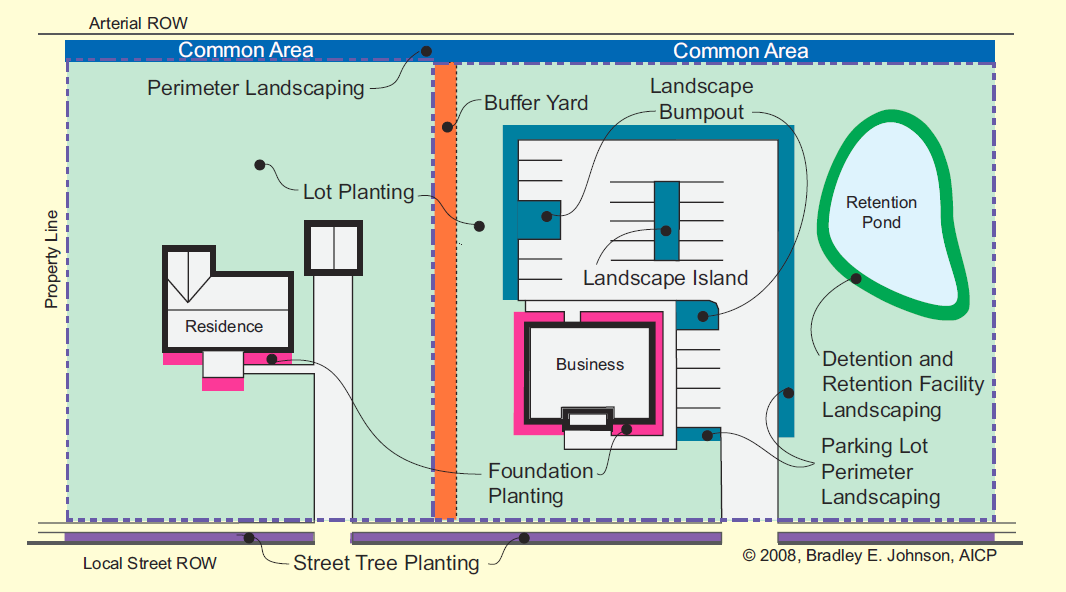
“Landscape buffer” means a continuous landscaped area designed, maintained and used for screening and separation of uses, lots, or structures.
“Landscape material” means trees, shrubs, plants, decorative fences, retaining walls, walls, earthen mounds, irrigation systems, flower beds, decorative rocks, edging, mulch, stakes, and the like. Artificial trees, shrubs, ground cover, and flowers are not considered landscape material.
“Landscape structure” means decorative fences, walls, retaining walls, edging, and the like materials.
“Landscaping” means the improvement of a lot with grass, shrubs, trees, and other vegetation and/or ornamental objects. Landscaping may include pedestrian walks, flower beds, berms, fountains, and other similar natural and manmade objects designed and arranged to produce an aesthetically pleasing effect.
“Legal nonconforming lot of record” means any legally established and recorded lot prior to the effective date of the ordinance codified in this title, or its subsequent amendments, that no longer meet the lot-specific development standards.
“Legal nonconforming sign” means any sign lawfully existing on the effective date of the ordinance codified in this title, or amendment thereto, that does not conform to all the standards and regulations of this title.
“Legal nonconforming structure” means any continuously occupied, lawfully established structure prior to the effective date of the ordinance codified in this title, or its subsequent amendments, that no longer meets the development standards.
“Legal nonconforming use” means any continuous, lawful use of structures, land, or structures and land in combination established prior to the effective date of the ordinance codified in this title or its subsequent amendments that is no longer a permitted use in the district where it is located.
“Liquid fertilizer storage” means the process of safely containing liquid fertilizer to prevent contamination and nutrient leakage. Liquid fertilizer can include fertilizer solutions, suspensions, slurries, and diluted fertilizers intended for the distribution as fertilizer.
“Loading space” means an off-street space for temporary parking of delivery and pickup vehicles.
Local Street. See “Street, local.”
“Lot” means a legally established piece of land under single or multiple ownership or control that is developable. Lot is a generic term inclusive of parent tract, parcel, tract, or platted lot. There are generally three types of lots identified in this title: interior lots, corner lots, and through lots.
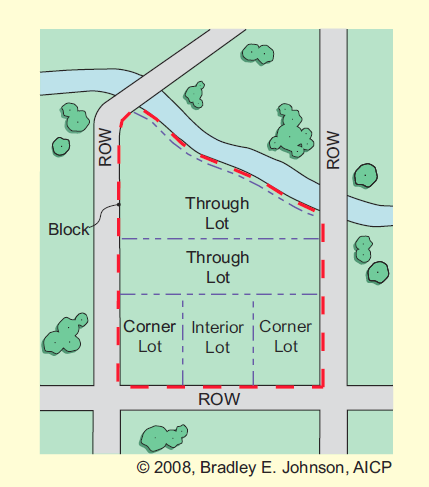
“Lot area” means the area of a horizontal plane bounded by the front, side, and rear lot lines, excepting any easement or right-of-way for public streets.
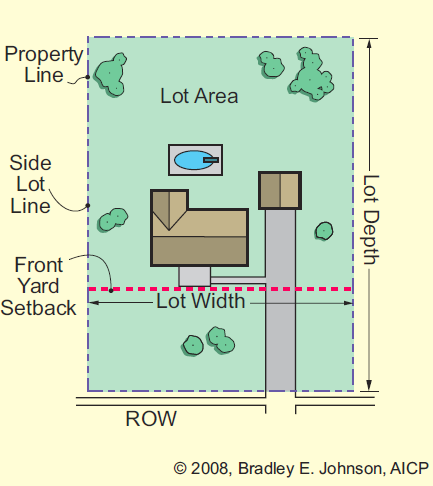
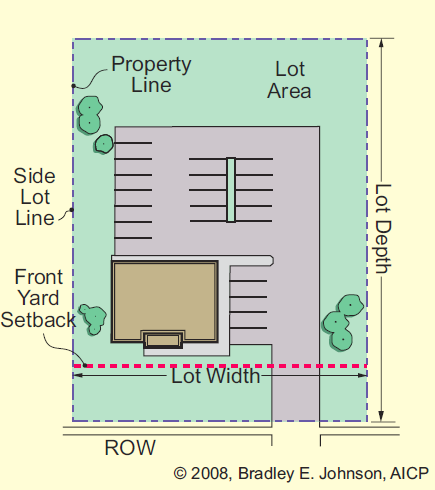
Lot, Buildable. See “Lot, improved.”
“Lot, corner” means a lot situated at the intersection of two streets or which fronts a street on two or more sides forming an interior angle of less than 135 degrees.
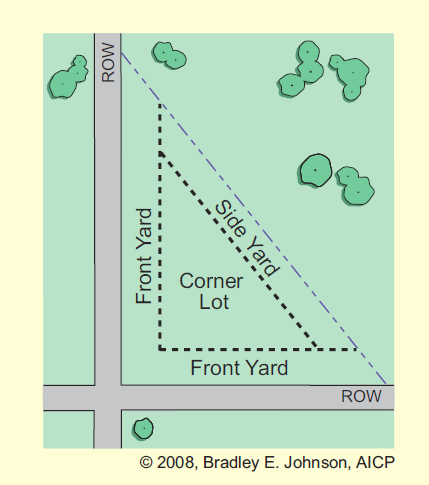
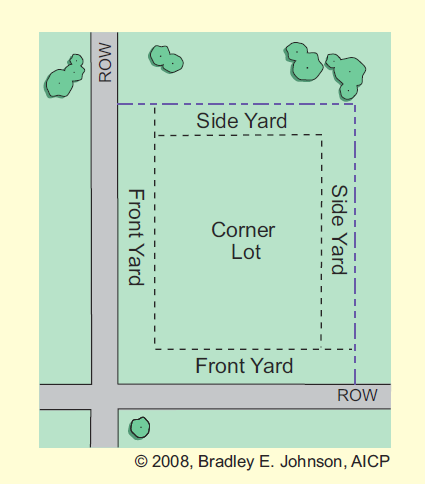
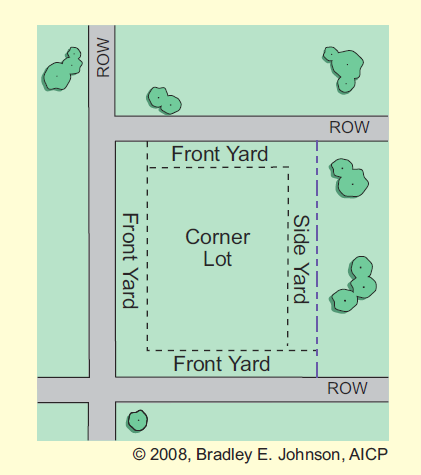
“Lot coverage” means the area of a lot occupied by the primary structure, any accessory structures, and impervious surface.
“Lot depth” means the horizontal distance between the front and rear lot lines. (See graphics for “Lot area.”)
“Lot, developed” means a lot with structures situated thereon.
“Lot frontage” means the length of the front lot line bordering upon a public right-of-way. The lot frontage is determined by measuring the total distance in which the front lot line touches a public right-of-way. Lot frontage requirement for a cul-de-sac lot is one-half the distance required for standard lots.
“Lot, improved” means a lot upon which a structure may be constructed and occupied as a result of the fact that it has frontage on and access to an improved street, meets minimum setback requirements, and has all necessary utilities available to the lot such as sewer, water, electricity, etc.
“Lot, interior” means a lot other than a corner lot or a through lot.
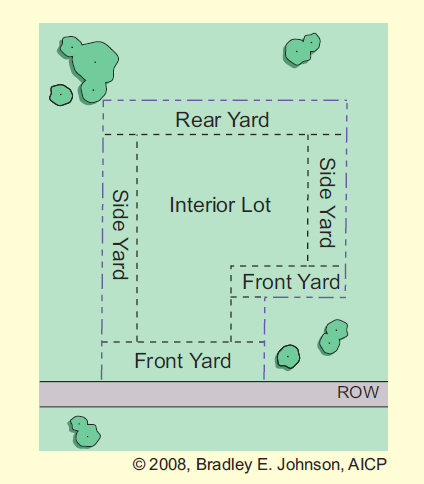
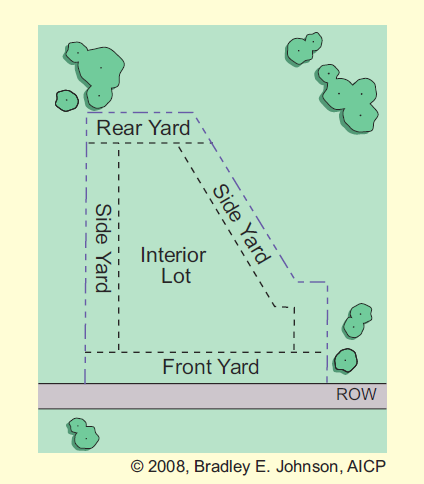
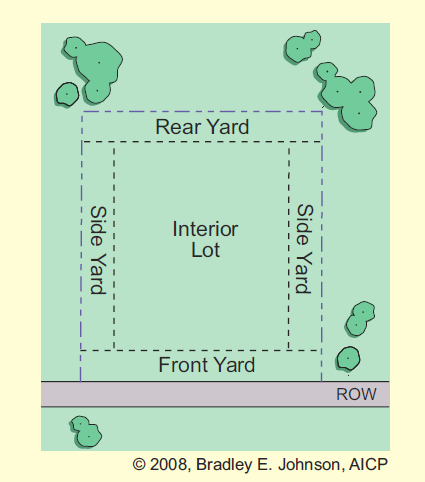
“Lot, lake front” means a lot fronting on a lake and a street. May also be referred to as a “lake front through lot” when the street and watercourse abut property lines that are relatively parallel.
“Lot line, front (corner lot)” means the line marking the boundary between the lot and each of the abutting streets.
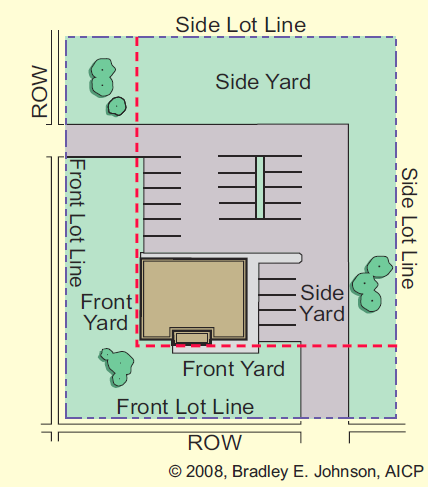
“Lot line, front (interior or through lot)” means the line marking the boundary between the lot and the abutting street, right-of-way or a lake or watercourse.
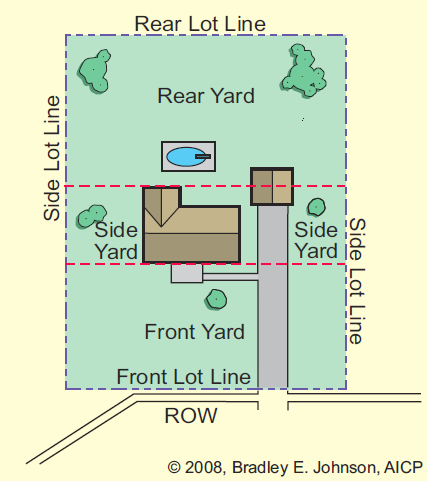
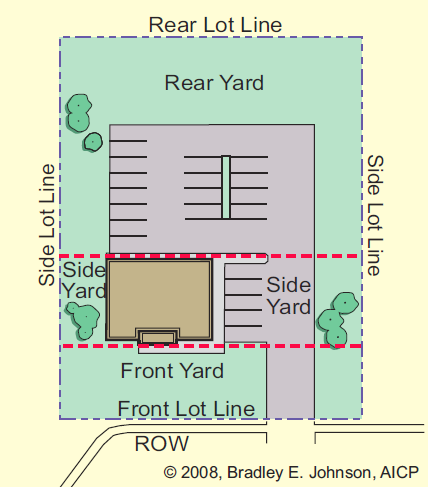
“Lot line, rear” means the lot line that is opposite the front lot line and farthest from it, except that for a triangular or other irregularly shaped lot, the line 10 feet long, parallel to the front lot line, and wholly within the lot, that is farthest from the front lot line. (See graphic for “Lot line, front.”)
“Lot line, side” means a lot boundary line other than a front or rear lot line. (See graphic for “Lot line, front.”)
“Lot of record” means a lot which is part of a subdivision recorded in the office of the County Recorder, or a parcel or lot described by metes and bounds, a description of which has been so recorded.
“Lot, platted” means a lot which is part of a subdivision of land recorded in the Office of the Steuben County Recorder.
“Lot, through” means a lot fronting on two parallel or approximately parallel streets, or abutting two streets which do not intersect at the boundaries of the lot. Also includes lots fronting on both a street and a watercourse or lake.
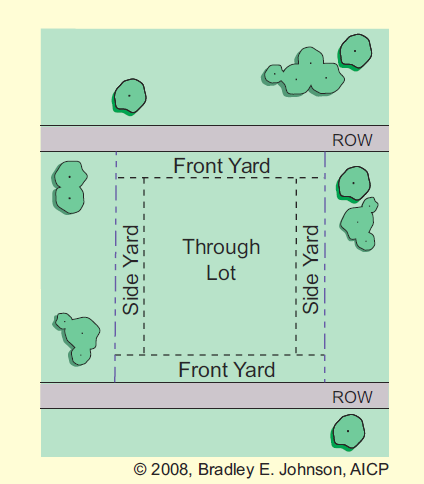
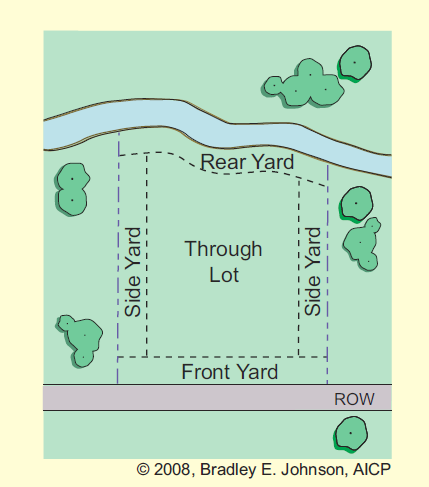
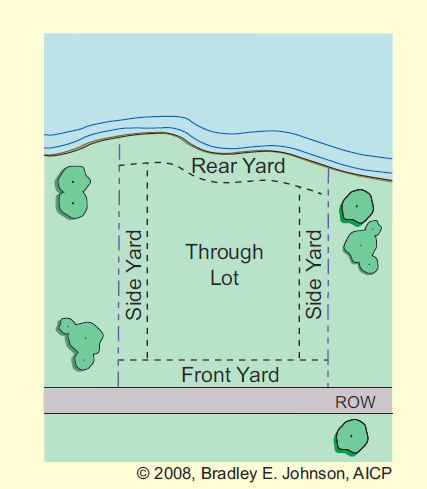
“Lot width” means the distance between the side lot lines as measured on the front setback line. Cul-de-sac and irregular shaped lots shall measure their front lot widths along the front setback line from one side lot line to the other. (See graphic for “Lot area.”)
“Lowest floor” means the lowest elevation described among the following:
(1) The lowest floor of a structure.
(2) The basement floor.
(3) The garage floor, if the garage is connected to the structure.
(4) The first floor of a structure elevated on pilings or constructed on a crawl space.
(5) The floor level of an enclosure below an elevated structure where the walls of the following requirements are satisfied:
(a) The walls are designed to automatically equalize hydrostatic flood forces by allowing for the entry and exit of flood water.
(b) At least two openings are designed and maintained for the entry and exit of flood water, and these openings provide a total area of at least one square inch for every one square foot of enclosed floor area subject to flooding. The bottom of an opening can be no more than one foot above grade. Doorways and windows do not qualify as openings under this clause.
“Luces” means the plural of lux.
“Lumens” means unit of luminous flux in the international system of units (SI) equal to one candela per steradian. Used to measure the amount of light emitted by lamps.
“Lux” means unit of illuminance in the international system of units (SI) equal to one lumen per square meter. [Ord. 1746-2023; Ord. 1352-2010; Ord. 1286-2008. UDO § 11.02.]
18.08.140 M definitions.
Main Floor Area. See “Floor area, main.”
“Maintenance surety” means a bond, letter of credit, or other security provided by the applicant that assures that the City of Angola would be provided the money necessary to repair or rebuild any public improvements associated with a project in the event the installed public improvements fail over the duration of the maintenance surety. Once established, a maintenance surety is irrevocable by the applicant until the established maintenance period has expired or the City of Angola releases the surety.
Major Subdivision. See “Subdivision, major.”
“Maneuvering space” means an open space in a parking area which:
(1) Is immediately adjacent to a parking space;
(2) Is used for and/or is necessary for turning, backing, or driving forward a motor vehicle into such parking space; but
(3) Is not used for the parking of or storage of motor vehicles.
Manufactured Home. See “Dwelling, manufactured home.”
“Manufactured home park” means a parcel of land containing two or more dwelling sites, with required improvements and utilities, that are leased for the long-term placement of mobile home dwellings and/or manufactured home dwellings, and shall include any street used or intended for use as part of the facilities of such manufactured home park. A manufactured home park does not involve the sales of mobile home dwellings or manufactured home dwellings in which unoccupied units are parked for inspection or sale.
“Manufacturing, heavy” means the assembly, fabrication, or processing of goods and materials using processes that ordinarily have greater than minimal impacts on the environment, or that otherwise do not constitute light manufacturing, and which may include open uses and outdoor storage. Heavy manufacturing generally includes processing and fabrication of products made from extracted or raw materials. Heavy manufacturing shall not include any use that is otherwise listed specifically in any zoning district as a permitted use or special exception.
“Manufacturing, light” means the assembly, fabrication or processing of goods and materials using processes that ordinarily do not create noise, smoke, fume, odors, glare, or health or safety hazards outside of the structure or lot where such assembly, fabrication, or processing of goods are housed entirely within an enclosed building including, but not limited to, sign painting and fabrication, cellphones, furniture, fabrics, and food. Light manufacturing generally includes processing and fabrication of finished products predominantly from previously prepared materials. Light manufacturing shall not include any use that is otherwise listed specifically in any zoning district as a permitted use or special exception.
“Marker (survey)” means a stake, pipe, rod, nail, or any other object which is not intended to be a permanent point for record purposes.
“Market value” means the price at which a structure, building, parcel or combination thereof would be sold for at present day.
“Massage parlor” means any place where, for any form of consideration or gratuity, massage, alcohol rub, administration of fomentations, electric or magnetic treatments, or any other treatment or manipulation of the human body occurs as part of or in connection with sexual conduct; or where any person providing such treatment, manipulation or service related thereto exposes specified anatomical areas.
Master Plan. See “Comprehensive Plan.”
“Maximum lot coverage” means the highest amount of impervious surface coverage permitted by this title.
Medical Office. See “Office, medical.”
“Metes and bounds” means boundaries of a property described from known points, angles (i.e., compass direction) and lengths of boundary lines.
Mini Warehouse. See “Warehouse storage facility.”
Minor Subdivision. See “Subdivision, minor.”
Mobile Home. See “Dwelling, mobile home.”
Mobile Home Park. See “Manufactured home park.”
“Monument (survey)” means a permanent physical structure which marks the location of a corner or other survey point.
“Motel” means an establishment consisting of a group of attached or detached living or sleeping accommodations with bathroom and closet space, located on a single zoning lot, and designed for use by transient automobile travelers. Transient rooms are accessed via an exterior corridor. A motel furnishes customary services such as maid service and laundering of linen, telephone, secretarial or desk service, and the use and upkeep of furniture.
Motor Home. See “Recreational vehicle.”
“Motor vehicle” means any passenger vehicle, truck, tractor, tractor-trailer, truck-trailer, trailer, boat, recreational vehicle, semitrailer, or any other vehicle propelled or drawn by mechanical power.
“Mound” means a landscape feature used for screening in which earth is piled up in irregular, round or oblong shapes. Particularly, mounds do not have consistent crest elevations, but are irregular in form and overlapping such to emulate a more natural landscape feature. Mounds in combination with other landscape material are used to block or partially block visibility from one side to the other.
“MS4 Coordinator” means the person assigned the role of administering and managing stormwater systems and activities pursuant to the provisions of IC 13-18-27 et seq.
“Multiple-family district” refers to the R4, R5, and UV districts.
Mural. See “Sign, mural.” [Ord. 1746-2023; Ord. 1286-2008. UDO § 11.02.]
18.08.150 N definitions.
“Nit” means a photometric unit of illuminative brightness equal to cd/m2 (candelas per square meter).
“Noise sensitive use” means the use of a structure for a purpose that would be adversely impacted by noise associated with nearby aircraft operations including aircraft overflights. “Noise sensitive uses” include but are not limited to residences, schools, churches, child care facilities, medical facilities, retirement homes, and nursing homes.
Nonconforming Building. See “Nonconforming structure.”
“Nonconforming lot of record” means a lot which was created such that it does not conform to the regulations of the district in which it is located.
“Nonconforming sign” means a sign or portion thereof which was designed, erected, or structurally altered such that it does not conform to the regulations of the district in which it is located.
“Nonconforming structure” means a structure or portion thereof which was designed, erected, or structurally altered such that it does not conform to the regulations of the district in which it is located.
“Nonconforming use” means a use which does not conform with the use regulations of the district in which it is located.
“Nudity” means the showing of the human male or female genitals, pubic area, vulva, or anus with less than a fully opaque covering, or the showing of the female breast with less than a fully opaque covering of any part of the nipple and areola.
“Nursing home” means a private home for the care of the aged or infirm, or any other person in need of nursing care; and which does not contain equipment for surgical care or for treatment of disease or injury, and is not primarily designed for patients being treated for mental illness or alcohol or drug addiction. [Ord. 1746-2023; Ord. 1425-2012 § 5; Ord. 1352-2010; Ord. 1286-2008. UDO § 11.02.]
18.08.160 O definitions.
“Observatory” means a structure, building, or lot containing telescopes and other instruments for observing astronomical objects, meteorological events, and other atmospheric and space phenomena.
“Office, construction trade” means a place in which electrical contractor, general contractor, heating and cooling contractor, landscaping contractor, plumbing contractor office, and the like, conduct administrative business. A construction trade office shall not include any service or construction yard.
“Office, general” means a place in which business, professional and/or clerical activities are conducted. “Offices” shall include government offices, professional services, design services, financial services, office functions which serve other off-site land uses, and general office services including but not limited to employment service, law office, real estate office, title company, trade office, etc.
“Office, medical” means a place in which emergency medical clinic, dental clinic, medical clinic, optical clinic, rehabilitation clinic, veterinarian clinic or hospital, and the like conduct business.
“Official zoning map” means a map of the City of Angola, Indiana, that legally denotes the boundaries of zoning districts as they apply to the properties within the planning jurisdiction. There is only one official zoning map, and it is kept up to date by the Plan Commission and the Zoning Administrator.
“Official zoning map copies” means a map of the City of Angola, Indiana, that legally denotes the boundaries of zoning districts as they apply to the properties within the planning jurisdiction. These maps may be out of date.
Off-Site Improvement. See “Improvement, off-site.”
“Open space” means an area of land not covered by structures, parking structures, or accessory structures except for recreational structures. “Open space” may include nature areas, streams, flood plains, meadows or open fields containing baseball fields, football fields, soccer fields, golf courses, swimming pools, bicycle paths, etc. “Open space” does not include street rights-of-way, platted lot area, private yard, patio areas, or land scheduled for future development.
“Ornamental tree” means a deciduous tree that does not grow to over 30 feet in height at maturity. Ornamental trees typically are flowering trees.
“OSHA” means Occupational Safety and Health Administration.
Outdoor Storage. See “Storage, outdoor.”
“Owner” means any person, group of persons, firm or firms, corporation or corporations, or any other legal entity having legal title to or sufficient proprietary interest in the land sought to be subdivided under these regulations, or their legal representative. [Ord. 1746-2023; Ord. 1286-2008. UDO § 11.02.]
18.08.170 P definitions.
“Parcel” means a legally established piece of land that was not created by or within a platted subdivision.
“Parent tract” means a parcel of land, or parcels of contiguous land with the same ownership and zoning, intended to be split into smaller lots, in regards to a subdivision of land.
“Park and recreation district” refers to the PR district.
“Park, private” means an area, restricted as to be used by a particular group, that is set aside for passive and/or active recreational opportunities and is of a noncommercial character.
“Park, public” means a parcel of land available to the public for passive and active recreation and is maintained and governed by the City of Angola.
“Parking lot, independent” means property in which parking of vehicles is the sole purpose of the property. An independent parking lot may be owned and operated by a private entity for private use or owned and maintained by a public entity for public use.
“Parking, required” means the minimum number of off-street parking spaces specified for a particular use or uses by this title.
“Parking space, automobile” means space within a public or private parking area for the storage of one passenger automobile or commercial vehicle under a one-and-one-half-ton capacity.
“Parking structure” means a parking garage.
“Passing blister” means an extension of a road’s width allowing vehicles to pass to the right of a car that is stopped and waiting to turn left.
“Paved surface” means a durable surface for parking, driving, riding, or similar activities that utilizes asphalt, concrete, brick, paving blocks, or similar material. Crushed gravel, stone, rock, dirt, sand, or grass are not permitted as a paved surface.
“Performance surety” means a bond, letter of credit, or other security provided by the applicant that assures that the City of Angola would be provided the money necessary to finish or fix any public improvements associated with a project in the event the applicant cannot, does not, or otherwise defaults on making the required or committed public improvements. Once established, a performance surety is irrevocable by the applicant until the project is finished, inspected, and released by the City of Angola.
“Performing arts center” means a building which is used for dance, musical, and acting performances to audiences. Ancillary uses may include rehearsal and training studios, ticket sales, vending, and administrative offices.
“Permanent foundation” means a structural system for transposing loads from a structure to the earth at a depth below the established frost line without exceeding the safe bearing capacity of the supporting soil.
“Permanent outdoor display area” means an outdoor area used to display merchandise that can be picked and purchased or viewed and rented by customers. Outdoor display include areas partially or fully enclosed by walls and/or fences, and open sided areas with a canopy or roof structure, and the like. Outdoor display does not include merchandise stored outdoors when located in an area that is not accessible to customers, or that is packaged or stacked in a manner that makes it difficult or dangerous for customers to pick product, or that is packaged or stacked in a manner consistent with warehousing.
“Permanent perimeter enclosure” means a permanent perimeter structural system completely enclosing the space between the floor joists of the home and the ground, except for the necessary openings, constructed in accordance with the One- and Two-Family Dwelling Code.
Permitted Use. See “Use, permitted.”
“Person” means a corporation, firm, partnership, association, organization, unit of government, or any other group that acts as a unit, as well as a natural person.
“Personal service” means an establishment, other than an office, in which services other than health care are rendered to consumers on an individual basis, such as barber shops and beauty parlors.
“Places of worship” means a building wherein persons regularly assemble for religious worship and which is maintained and controlled by a religious body organized to sustain public worship. Includes church, synagogue, temple, mosque or other such place for worship.
“Plan Commission” means a plan commission serving a single local government jurisdiction established as defined under IC 36-7-1-2 (1983) as amended. The Angola Plan Commission is an advisory plan commission.
“Planned development” (“PD”), referred to as a “planned unit development” in the Indiana Code, means a large-scale unified development meeting the requirements for zoning approval under the planned development provisions of Chapter 18.192 AMC, Processes. Generally a planned development consists of a parcel or parcels of land, controlled by a single landowner, to be developed as a single entity, which does not correspond in size of lots, bulk or type of structures, density, lot coverage, and required open space to the regulations established in any district of this title. This may result in more attractive and affordable development than conventional developments would allow. Clustered housing (dwellings built in innovative lot arrangements around common open space) and zero lot line housing (dwellings built immediately adjacent to lot lines) are possible as part of planned developments. A planned development requires approval through a zoning map amendment.
Planning Director. See “Zoning Administrator.”
“Planning jurisdiction” means the City of Angola, Indiana, city limits and the contiguous unincorporated extraterritorial jurisdictional area over which the city exercises planning and zoning authority.
“Planning staff” means the Zoning Administrator and all employees of the Plan Commission of the city under the supervision of the Zoning Administrator and subject to the authority of the Zoning Administrator.
“Plant nursery” means the use of land, buildings or structures, or portions thereof, where trees, shrubs or other plants are grown for the purpose of retail or wholesale trade. A plant nursery may include the accessory sale of soil, planting materials, fertilizers, garden equipment, ornaments and similar material.
“Plat” means a drawing, map, or plan that shows a division of land and/or the layout for subdivisions that is intended to be filed for record.
“Plat amendment” means a change in a recorded subdivision, if such change affects any street layout or area reserved for public use, or any lot line or easement, or if it affects any map or plan legally recorded.
Plat, Primary. The primary plat, pursuant to IC 36-7-4-700 et seq., is the plat and plans upon which the approval of a proposed subdivision are based. The primary plat and plans shall be subject to public notice and public hearing according to law and according to Plan Commission rules. (Under former state statutes, the primary plat was referred to as a “preliminary” plat.)
Plat, Secondary. The secondary plat, pursuant to IC 36-7-4-700 et seq., is the final plat document in recordable form. A secondary plat shall substantially conform with the preceding primary plat, or section thereof. The secondary plat and plans are not subject to public notices and public hearings.
Platted Lot. See “Lot, platted”
Pool, Swimming. See “Swimming pool.”
“Porch” means a roofed-over structure projecting out from the wall or walls of a main structure and commonly open to the weather in part.
“Power generation facility” means a facility used to generate electrical power such as a wind power facility or solar power facility.
“Practical difficulty” means a difficulty with regard to one’s ability to improve land stemming from regulations of this title. A practical difficulty is not a hardship, rather it is a situation where the owner could comply with the regulations within this title, but would like a variance from the development standards to improve his site in a practical manner. For instance, a person may request a variance from a side yard setback due to a large tree which is blocking the only location that would meet the development standards for a new garage location.
Primary Arterial. See “Street, primary arterial.”
Primary Plat. See “Plat, primary.”
“Primary structure” means the structure in which the use of the lot or premises is located or conducted; with respect to residential uses, the primary structure shall be the main dwelling.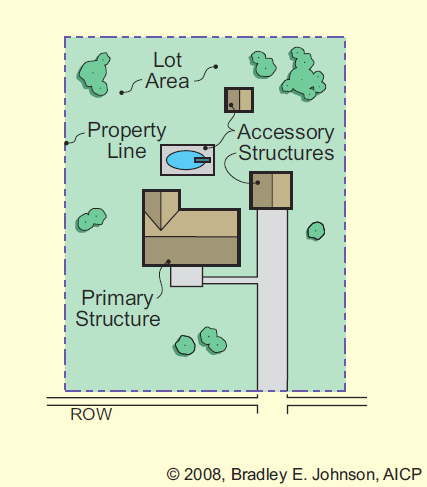
Primary Use. See “Use, primary.”
Principal Use. See “Use, primary.”
“Prison” means a facility in which convicted criminals are confined to serve a sentence. In general, a prison facility is used for long-term sentences.
Private Street. See “Street, private.”
“Prohibited use” means a use that is not permitted under any circumstances.
“Public improvements” means any storm drainage facility, street, highway, parkway, sidewalk, pedestrian way, tree, lawn, off-street parking area, lot improvement, utility, or other facility for which the local government may ultimately assume the responsibility for maintenance and operation, or which may affect an improvement for which local government responsibility is established.
“Public or private parking area” means a group of parking spaces in an open area not including any part of a street or alley, designed or used for temporary parking of motor vehicles.
“Public safety and nuisance” means anything that is injurious to the safety or health of an entire community, neighborhood or any considerable number of persons, or unlawfully obstructs the free passage or use, in the customary manner, of any navigable lake, or river, bay, stream, canal, or basin.
Public Street. See “Street, public.”
Public Utility. See “Utility, public.”
“Public way” means highways, streets, avenues, boulevards, roads, lanes, alleys, trails, or sidewalks. [Ord. 1746-2023; Ord. 1286-2008. UDO § 11.02.]
18.08.180 Q definitions.
Reserved. [Ord. 1746-2023; Ord. 1286-2008. UDO § 11.02.]
18.08.190 R definitions.
“Radio or TV station” means the broadcast structure for the production of radio and television programing, not to include any telecommunication towers.
“Raising of farm animals” means any livestock operation that falls below the thresholds of a confined feeding operation as defined by the Indiana Department of Environmental Management.
Rear Lot Line. See “Lot line, rear.”
Rear Yard. See “Yard, rear.”
“Recreation center or play center” means an enclosed structure containing recreational facilities, such as a tennis court, swimming pool, and/or gymnasium. This shall not include outdoor amphitheaters, tennis courts, or swimming pools.
“Recreational vehicle” means a vehicular-type portable structure without permanent foundation that can be towed, hauled, or driven and primarily designed as a temporary living accommodation for recreational, camping, and travel use and including, but not limited to, travel trailers, truck campers, camping trailers, boats, and self-propelled motor homes. A recreational vehicle shall not be used as living quarters.
“Recreational vehicle park” means a facility designed for short-term occupancy for recreational vehicles only.
“Registered land surveyor” means a land surveyor properly licensed and registered or through reciprocity permitted to practice in the state of Indiana.
“Registered professional engineer” means an engineer properly licensed and registered or through reciprocity permitted to practice in the state of Indiana.
“Regularly” means the consistent and repeated doing of an act on an ongoing basis.
Replat. See “Plat amendment.”
“Research building” means a building used for scientific, technology, agricultural research, including product testing.
“Residence hall” means a building containing living quarters for students and staff supervisors (e.g., residence hall director), including common area, lounge, vending, bathrooms and other amenities predominantly intended for students that live in the residence hall.
“Residential district” refers to the ER, R1, R2, R3, TR, LR, and MH districts.
“Residential facility for the developmentally disabled (large)” means a residential facility which provides residential services for more than eight developmentally disabled individuals as described in IC 12-28-4.
“Residential facility for the developmentally disabled (small)” means a residential facility which provides residential services for eight developmentally disabled individuals or less as described in IC 12-28-4.
“Residential facility for the mentally ill” means a residential facility which provides residential services for mentally ill individuals as described in IC 12-28-4. No two residential facilities for the mentally ill shall be within 3,000 feet of one another in the planning jurisdiction as stated in Indiana Code.
Responsible Party. For purposes of issuing notice of violation, the following persons shall be considered responsible parties, with liability for fines and responsibility for remedy of the violation: the property owner(s), persons with any possessory interest in the property, and/or any persons and/or their agents who have caused the violation. Any owner, tenant, builder, developer, possessor of interest, architect, designer, property manager, equipment operator known or suspected to be responsible in part or in whole for a violation of this title.
“Restaurant” means an establishment whose use is the selling of food in a ready-to-consume state, in individual servings, in which the customer consumes these foods while seated at tables or counters located in or immediately adjacent to the building in which the use is located, and which may include carry-out service. “Restaurant” shall include that portion of any establishment which sells prepared food, such as a bakery or a delicatessen, and which is used for seating for the consumption of food on the premises. (See also “Drive-through establishment.”)
“Retail sales, high intensity” means a business establishment that has a significant impact on land, neighboring properties, traffic generation, or public safety. High intensity retail sale establishments shall not have a maximum or minimum area regulation. Examples of high intensity retail sales may include but are not limited to department store, furniture shop, grocery store, home electronics or appliance store, office supply store, sporting goods store.
“Retail sales, low intensity” means a business establishment that has very little impact on land, neighboring properties, traffic generation, or public safety. Low intensity retail sale establishments shall not exceed 7,500 square feet in main floor area. Examples of low intensity retail sales may include but are not limited to art gallery, bakery, book store, boutique, drug store, gift shop, jewelry store, shoe store and repair.
“Retail sales, medium intensity” means a business establishment that has moderate impact on land, neighboring properties, traffic generation, or public safety. Medium intensity retail sale establishments shall not exceed 20,000 square feet in main floor area. Examples of medium intensity retail sales may include but are not limited to antique shop, art and craft supply, computer sales, convenience store, drycleaning services, party or event store, print shop or copy center.
“Retail sales, special” means a business establishment that sells products that require special handling due to risks of public safety. Examples include farm implement store, firework sales, gun sales, hunting store, manufactured home sales.
“Retirement community” means an age-restricted development, which may include detached and attached dwelling units and apartments.
“Right-of-way” means a strip of land occupied or intended to be occupied by transportation facilities, public utilities, or other special public uses. Rights-of-way intended for any use involving maintenance by a public agency shall be dedicated to the public use by the maker of the plat on which such right-of-way is established.
Road. See “Street.”
“Roadside sales” means sale of produce grown on the lot where the sales takes place or locally on neighboring farms.
“Root protection zone” means, generally, 18 to 24 inches deep and a distance from the trunk of a tree equal to one-half its height or its drip line, whichever is greater.
ROW. See “Right-of-way.” [Ord. 1746-2023; Ord. 1425-2012 § 5; Ord. 1286-2008. UDO § 11.02.]
18.08.200 S definitions.
“Sale of agricultural products” means the use of land, buildings or structures, or portions thereof, where agricultural products are sold. Agricultural products may be grown on site or off site.
“Satellite dish or antenna” means an apparatus capable of receiving communications from a transmitter relay located in a planetary orbit or broadcasted signals from transmitting towers.
“School” means a public or private institution which offers instruction in any of the branches of learning and study comparable to that taught in the public schools under the Indiana school laws, including prekindergarten, kindergarten, elementary school, and junior and senior high schools, but excluding trade, business, or commercial schools.
“School, trade, business or commercial” means an educational facility which offers instruction specific to a trade, business, or commercial practice.
“Scrap metal yard” means a general industrial use established independent or ancillary to and connected with another general industrial use, which is concerned exclusively in new and salvaged metal pipes, wire, beams, angles, rods, machinery, parts, filings, clippings, and/or all other metal items of every type, and which acquires such items incidental to its connection with the other general industrial use or by purchase, consignment or bailment which stores, grades, processes, melts, cuts, dismantles, compresses, cleans, or in any way prepares said items for reuse by the connected other general industrial use or for storage, sale or shipment and/or use in other industries or businesses including open hearth, electric furnaces and foundry operations. Such an establishment shall not include junkyards, dumps, or automobile or other vehicle graveyards.
Secondary Plat. See “Plat, secondary.”
“Self-storage facility” means a building or group of buildings containing separate, individual, and private storage spaces of varying sizes available for lease or rent.
“Semi-nude” or “semi-nudity” means the showing of the female breast below a horizontal line across the top of the areola and extending across the width of the breast at that point, or the showing of the male or female buttocks. This definition shall include the lower portion of the human female breast, but shall not include any portion of the cleavage of the human female breasts exhibited by a bikini, dress, blouse, shirt, leotard, or similar wearing apparel provided the areola is not exposed in whole or in part.
“Semi-nude model studio” means a place where persons regularly appear in a state of semi-nudity for money or any form of consideration in order to be observed, sketched, drawn, painted, sculptured, photographed, or similarly depicted by other persons. This definition does not apply to any place where persons appearing in a state of semi-nudity did so in a class operated:
(1) By a college, junior college, or university supported entirely or partly by taxation;
(2) By a private college or university which maintains and operates educational programs in which credits are transferable to a college, junior college, or university supported entirely or partly by taxation; or
(3) In a structure:
(a) Which has no sign visible from the exterior of the structure and no other advertising that indicates a semi-nude person is available for viewing; and
(b) Where, in order to participate in a class, a student must enroll at least three days in advance of the class.
“Semi tractor gas station” means any land, building, structure, or premises that is specifically made for commercial vehicles such as box trucks, semi-trucks, etc., and is used for the retail sale of vehicle fuels, oils, and accessories.
“Semi tractor wash” means a structure, or portion of a structure, containing facilities for washing one or more commercial vehicles, such as box trucks or semi-trucks, at any one time, using production line methods such as a chain conveyor, blower, steam cleaning device, or other mechanical devices; or providing space, water, equipment, or soap for the complete or partial cleaning of such commercial vehicles, whether by operator or by customer.
“Setback” means the minimum horizontal distance between the building line and a lot line or right-of-way.
“Setback, average” means an average of the front yard setbacks of structures on either side of the subject property. If the average setback encroaches into the right-of-way, permission is not required from the Board of Zoning Appeals, but shall obtain approval from the Board of Public Works and Safety for an encroachment. If the subject property is a corner lot, the average of the front yard setback of structures adjacent to the subject property, along with the front yard setback of structures directly across the street of the subject property must be used.
“Setback, established” means the average setback distance of all structures on the side of a street between two intersecting streets. Such line shall be redetermined as each successive vacant lot is proposed to be improved with a structure.
“Sexual device” means any three-dimensional object designed for stimulation of the male or female human genitals, anus, buttocks, female breast, or for sadomasochistic use or abuse of oneself or others and shall include devices commonly known as dildos, vibrators, penis pumps, cock rings, anal beads, butt plugs, nipple clamps, and physical representations of the human genital organs. Nothing in this definition shall be construed to include devices primarily intended for protection against sexually transmitted diseases or for preventing pregnancy.
“Sexual device shop” means a commercial establishment that regularly features sexual devices. This definition shall not be construed to include any pharmacy, drug store, medical clinic, any establishment primarily dedicated to providing medical or healthcare products or services, or any establishment that does not regularly advertise itself or hold itself out, in any medium, as an establishment that caters to adult sexual interests.
“Sexually oriented business” means an adult bookstore or adult video store, an adult cabaret, an adult motion picture theater, a semi-nude model studio, or a sexual device shop.
“Shooting range” means an area designed and used for archery or sport shooting, including, but not limited to, sport shooting that involves the use of rifles, shotguns, pistols, silhouettes, skeet, trap, black powder or other similar items.
Side Lot Line. See “Lot line, side.”
Side Yard. See “Yard, side.”
“Sidepath” means a pedestrian facility similar to a sidewalk, but wider to accommodate walkers, joggers, cyclists and strollers; usually constructed from asphalt.
“Sign” means any name, identification, description, display, or illustration which is affixed to, painted on, or is represented directly or indirectly upon a building, structure, or piece of land, and which directs attention to an object, product, place, activity, person, institution, organization, or business. Religious symbols on places of worship or structures owned and operated by religious organizations are not considered a sign unless accompanied with text. Address numbers are not considered a sign.
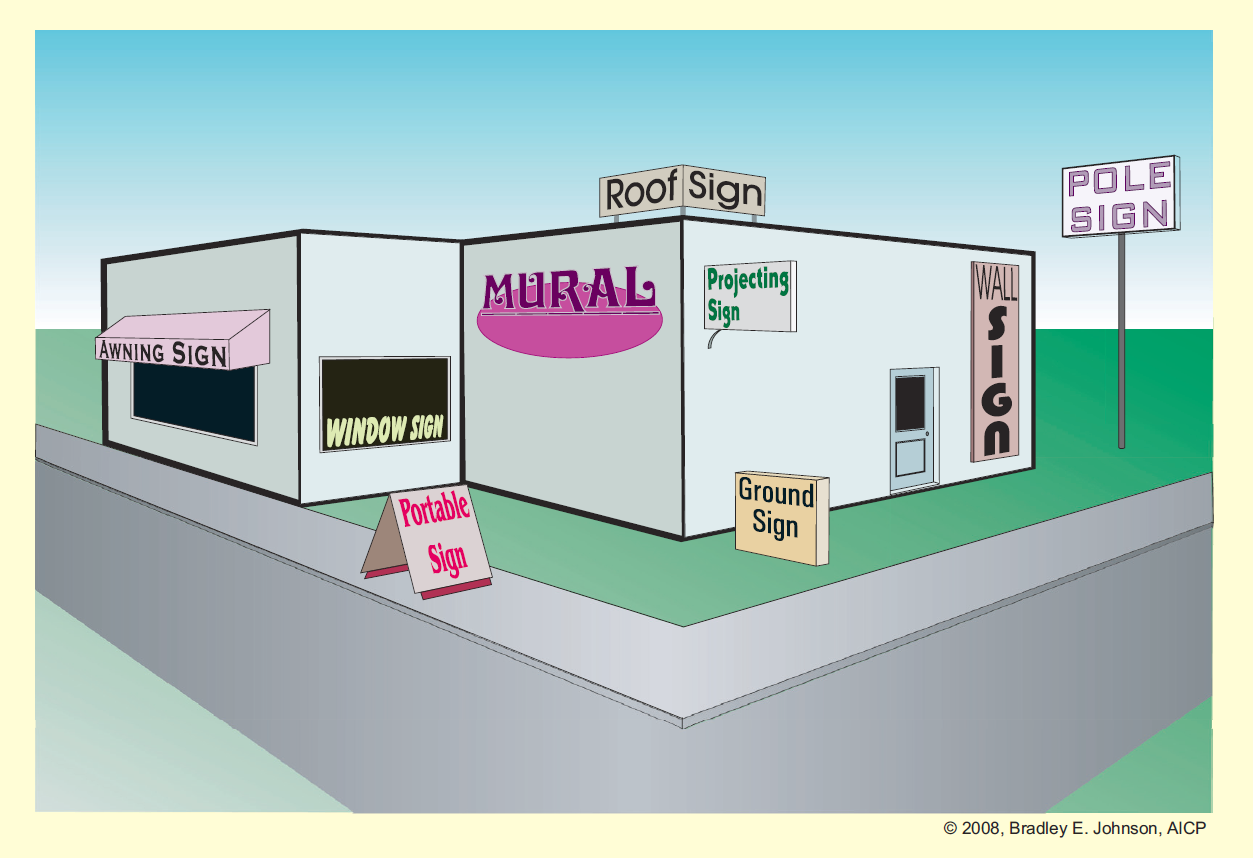
“Sign area” means the entire area within a single continuous perimeter enclosing the extreme limits of a sign, including all background area figures and letters. However, such perimeter shall not include any structural elements lying outside the limits of the sign which are not part of the information, visual attraction or symbolism of the sign.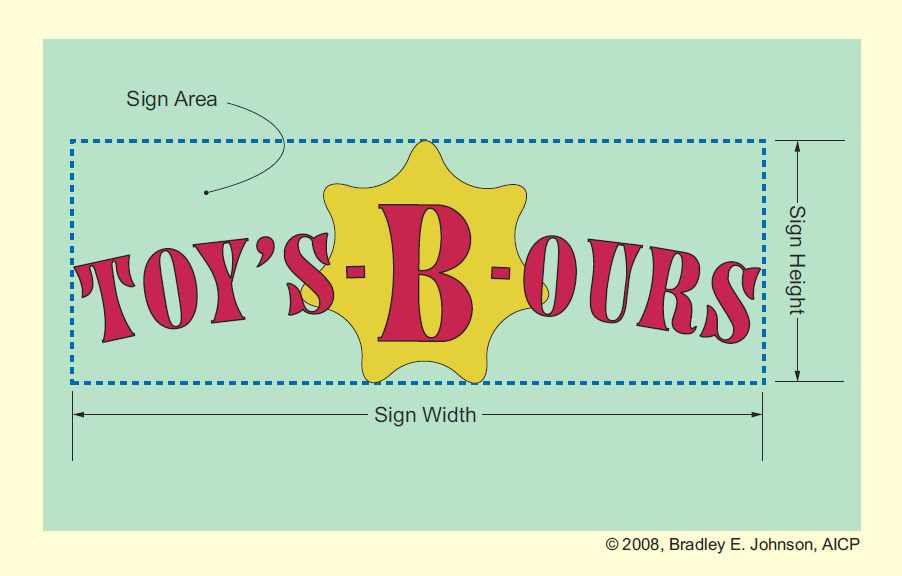
“Sign, changeable copy” means a device that allows a message, graphic, or light intensity to be changed periodically using either:
(1) Physical letters, numbers, or shapes temporarily attached to a sign face; or
(2) Electronic signals transmitted to an LED, LCD, or similar electronic display.
A changeable copy sign may also be referred to as “changeable copy.”
“Sign, construction” means a sign directing attention to construction upon the property where the sign is displayed, and bearing the name, address, sublot number, or other identifier of the contractor, subcontractor, and/or architect.
“Sign, cyclical message” means a changeable copy sign with a change rate of once every seven seconds or greater, but not greater than once every six hours (e.g., a cyclical message at a school that announces upcoming events, time and temperature). May also be referred to as a “cyclical message.”
“Sign, directional device” means a sign intending to direct the safe flow of vehicular and pedestrian traffic and includes “enter,” “exit,” and “arrow” signs.
“Sign, election” means a temporary sign used to advertise for an election or a candidate for said election as described in IC 3-5-1-2.
“Sign, electronic changeable copy” means a cyclical message sign or changeable copy sign that allows a message to be changed every seven seconds or greater time using electronic signals transmitted to an LED, LCD, or similar electronic display.
“Sign, entryway feature” means a ground sign that identifies the entrance to a subdivision installed in common area and typically inclusive of hardscape, landscape, and other built features that portray the character of the subdivision.
“Sign face” means the surface intended for the display of information on the sign.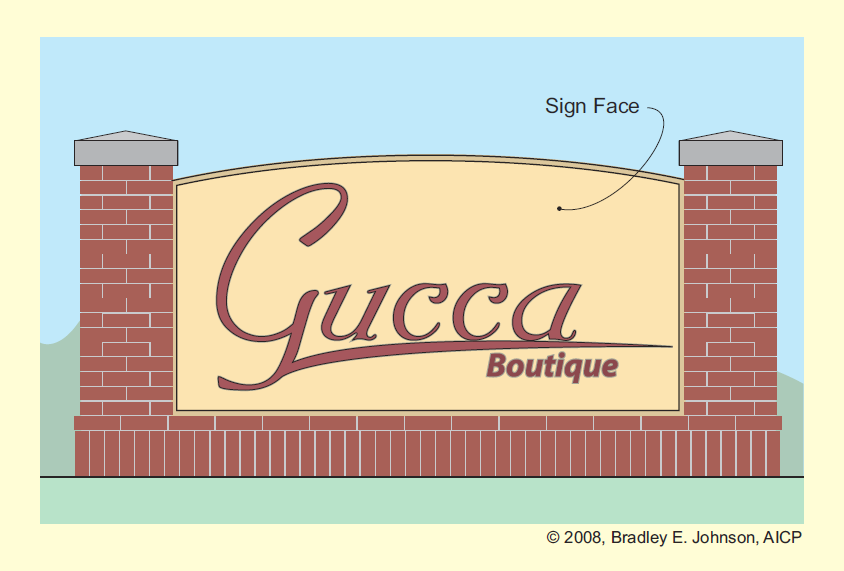
“Sign, flashing message” means a changeable copy sign with a change rate of less than seven seconds, including the change rate of any single pixel or light element on the sign (e.g., text that pans in and out, text that turns on and off rapidly, text that moves, and video and motion graphics). May also be referred to as a “flashing message.”
“Sign, gateway” means a ground sign that identifies a nonsubdivided, commercial development, multifamily development or mobile home community.
“Sign, ground” means a sign in which the bottom edge of the sign is permanently affixed to the ground. A “monument sign” is another name for a ground sign. (See graphic for “Sign.”)
“Sign, illuminated” means a sign which has characters, letters, figures, designs, or outline illuminated by electric lights or luminous tubes as a part of the sign, or which is illuminated by reflectors.
“Sign, manual changeable copy” means a changeable copy sign that allows a message to be changed periodically using physical letters and numbers, typically made of plastic, that affix to the sign (e.g., snap to the sign face or inserted into a channel).
Sign, Monument. See “Sign, ground.”
“Sign, mural” means a sign painted onto the side of a wall, ground, or structure. A mural sign is regulated as a wall sign in this title. (See graphic for “Sign.”)
Sign, Nonconforming. See “Nonconforming sign.”
“Sign, permanent” means a sign that is designed or intended to be used indefinitely, or used indefinitely without change in the same state or place, including, but not limited to, business signs, directional signs, residential complex or subdivision signs, and illuminated signs.
“Sign, permanent display board” means a permanent device used to post temporary signs (e.g., a permanently installed bulletin board).
“Sign, pole” means a sign that is supported by one or more poles, posts, or braces upon the ground, not attached to or supported by any structure, with a clear space in excess of six feet from the finished grade to the bottom of the sign face. (See graphic for “Sign.”)
“Sign, projecting” means any sign other than a wall sign affixed to any structure or wall whose leading edge extends beyond such structure or wall. (See graphic for “Sign.”)
“Sign, real estate” means a sign announcing the sale, rental, or lease of the lot where the sign is displayed, or announcing the sale, rental, or lease of one or more structures, or a portion thereof, located on such lot, and identifying the owner, realty agent, telephone numbers, or open house information.
“Sign, roof” means a sign which is erected, constructed, and maintained above any portion of the roof. (See graphic for “Sign.”)
“Sign, static message” means a device that maintains the same message, graphic, or light intensity for at least six hours. May also be referred to as a “static message.”
“Sign, temporary” means an advertising device not fixed to a permanent foundation.
“Sign, tenant listing” means an advertising device fixed to a common area of a development for directing the public to businesses within that development.
“Sign, wall” means a sign attached to and/or integral with exterior wall or window surface of a structure, the face of which is parallel to the surface, no part of which extends above the eaves on the structure. (See graphic for “Sign.”)
“Sign, wayfinding system” means a device that provides guidance to the public to prevent confusion and encourage efficient and safe directions to a destination.
“Sign, window” means a device attached to and/or integral with the window surface of a building that is visible outside, the face of which is parallel to the surface.
“Sign, yard” means an advertising device comprised of one or more legs that are pressed into the ground.
“Site plan” means a map of a site, drawn accurately to scale, showing existing and proposed features of the site including but not limited to structures, circulation, grading, trees, and landscaping, sufficient for review. A site plan shall serve as the development plan regulated by IC 36-7-4-1400.
“Special exception” means the authorization of a use that is designated as such by this title as being permitted in the district concerned if it meets special conditions, is found to be appropriate and upon application, is specifically authorized by the Board of Zoning Appeals.
“Specified anatomical areas” means and includes:
(1) Less than completely and opaquely covered: human genitals; pubic region; buttock; and female breast below a point immediately above the top of the areola; and
(2) Human male genitals in a discernibly turgid state, even if completely and opaquely covered.
“Specified sexual activity” means any of the following:
(1) Intercourse, oral copulation, masturbation or sodomy; or
(2) Excretory functions as a part of or in connection with any of the activities described in subsection (1) of this definition.
“Specimen tree” means trees with a diameter at breast height (DBH) of 24 inches or greater.
“Sports complex” means an indoor or outdoor facility that is designed for sport activities, training, competition, games and spectating that is open to the public or open to members. Sport facilities may include ice skating rink, roller skating rink, football field, baseball diamond, soccer fields, volleyball courts, swimming pool, skate park, bicycle park, velodrome, tennis court or combinations thereof.
“Stable, commercial” means an agricultural commercial operation utilizing one or more structures for the shelter, feeding, riding, or working of horses. A commercial stable may offer boarding, riding lessons, trail rides, and similar services to the public.
“Stable, private” means an accessory use utilizing one or more accessory structures for shelter, feeding, riding, or working with horses owned by the occupants of the dwelling.
“State” means, when capitalized, the state of Indiana.
“Storage, outdoor” means the outdoor accumulation of goods, junk, motor vehicles, equipment, products, or materials for permanent or temporary holding.
“Story” means that portion of a structure included between the surface of any floor and the surface of the floor next above it, or if there be no floor above it, then the space between the floor and the ceiling next above it. Any portion of a story exceeding 14 feet in height shall be considered as an additional story for each 14 feet or fraction thereof.
“Street” means any vehicular right-of-way that:
(1) Is an existing state, county, or municipal roadway;
(2) Is shown upon a plat approved pursuant to law;
(3) Is approved by other official action; or
(4) Is shown on a plat duly filed and recorded in the office of the county recording officer prior to the appointment of a Plan Commission and the grant to such Plan Commission to review plats; includes the land between the street lines, whether improved or unimproved.
“Street, access” means a street within a development that provides access to lots and their users which is privately owned and maintained.
“Street, arterial” means a street with access control and restricted parking, that collects and distributes traffic to and from secondary arterials. State and federal streets and highways are considered primary arterials.
“Street, collector” means a street that is designed to carry high volumes of traffic, as depicted by the thoroughfare plan.
“Street, frontage” means a street that is parallel to and adjacent to a major thoroughfare or highway and which provides access to abutting properties.
“Street, interior” means a street within a development that provides access to lots that do not have access to a perimeter street. The hierarchical classification is not relevant.
“Street, local” means a street designed primarily to provide access to abutting properties and discourage through traffic, as depicted by the pavement management system maintained by the Angola Street Department.
“Street, perimeter” means a preexisting street that a new subdivision or development abuts.
“Street, private” means vehicular streets and driveways that are maintained by the owner(s) and that are wholly within private property except where they intersect with other streets within public rights-of-way.
“Street, public” means all property dedicated or intended for public highway, freeway, or roadway purposes or subject to public easements therefor.
“Structural alteration” means any change in the supporting members of a structure such as bearing walls, partitions, columns, beams or girders, or any change in the footprint or increase in the size of living space. Also, substantial roofing and siding work when repairs are made to the structure beneath.
“Structure” means:
(1) Anything constructed, installed, or placed on a lot that is fastened to a foundation or that rests on a foundation; or
(2) Anything constructed, installed, placed or parked on a lot and used for storage, recreation, employment, commerce, occupancy, shelter, containment of animals, or aesthetic enhancement; or
(3) Any sign constructed, installed, placed or staked on a lot; or
(4) Any heating, ventilation, or air conditioning (HVAC) equipment constructed, installed, or placed on a lot; or
(5) Any tower, pole or frame used to mount an antenna, light fixture, sign, weather instrument, mailbox, or sport apparatus; or
(6) Any fence, wall, enclosure, retaining wall or raised bed garden; or
(7) Any material (e.g., stone, gravel, cobblestones, porous pavers, asphalt, concrete, bricks, or wood) placed on the ground, or any engineered method or enhancement to the earth used to stabilize or enhance the durability of the earth for the purpose of conveying, parking or storing vehicles; or
(8) Any permanent foundation or subgrade element that is constructed, installed, or placed on a lot; or
(9) Any outdoor living amenity, outdoor fireplace, or fixed cooking device that is constructed, installed, or placed on a lot; or
(10) Any above grade mechanical equipment, pump, digester, valve, fire hydrant, plumbing, pipeline, electrical equipment, substation, utility poles, cooling tower, storage tank, containment basin, or waste treatment system on a lot; or
(11) Any subgrade waste treatment system, well, irrigation system, culvert, tile, French drain, or drain constructed, installed, or placed on a lot; or
(12) Any manmade lake, pond, landscape pond, retention pond, detention pond, drainage swale, waterfall, or fountain constructed, installed, or placed on a lot or any man-placed boulder on a lot; or
(13) Any manmade berm, levy, dike, dam, hill, depression on a lot; or
(14) Any trash receptacle, dumpster, or recycling bin.
A “structure” shall not include:
(1) Anything enclosed within a building; or
(2) A semi tractor-trailer, bus, recreational vehicle, box truck, work truck, pickup truck, passenger vehicle, motorcycle or other vehicles used for transporting people or material that is licensed, fully operable, parked on an improved surface, and that is not being used for overnight occupancy or long-term storage; or
(3) Trees, shrubs, flowers, grass, and other living plants; or
(4) Outdoor furniture and nonfixed cooking devices when located on a porch, patio, deck or similar outdoor living space; or
(5) Construction material stored on site during the construction process; or
(6) Anything specifically or partially excluded as a structure within this title.
“Structure, detached” means a structure that has no structural connection with the primary structure or any other building or structure.
“Structure height” means the vertical distance measured from the top of the structure’s main floor surface (e.g., concrete slab, floor decking, dirt) to the highest point of the roof.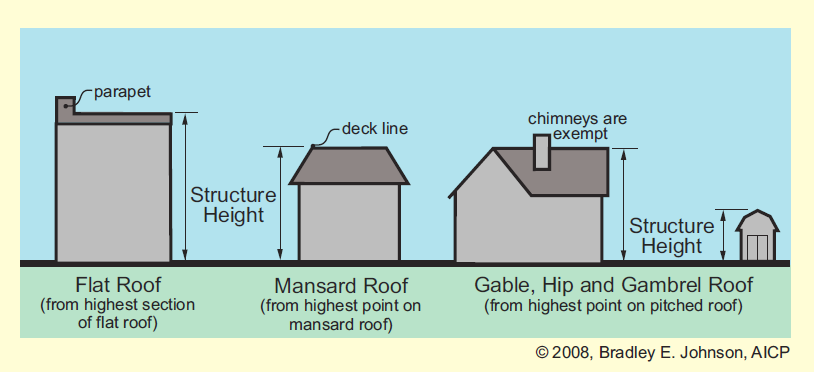
“Structure, primary” means any building used for occupancy, employment, or dwelling; or any structure in which the primary use of the lot on which it is situated is conducted.
“Structure, temporary” means a structure established for a limited and fixed period of time, with the intent to discontinue such structure upon the expiration of the time period.
“Student, alumni, or visitors center” means a structure associated with a university used for recreation, entertainment, lounges, wellness, socialization, and programming.
“Studio arts” means karate studio, dance studio, art studio, and the like.
“Subdivision” means the division of a parent tract or other piece of land into at least two smaller lots or the combination of two or more smaller lots into one lot so that, either now or in the future, the subdivider can transfer ownership, construct buildings, or establish a use other than vacant or create new building sites for leasehold, and as further defined in this title.
“Subdivision, administrative” means a process which may be approved by the Zoning Administrator by which property owners may make minor changes to their lot lines, divide large agricultural lots into smaller agricultural lots, and divide land for telecommunication facilities.
“Subdivision, major” means a process which shall be approved by the Plan Commission that legally subdivides land into four or more lots, includes a new public or private road, requests waivers, or includes a common area.
“Subdivision, minor” means a process which may be approved by the Plat Committee which legally subdivides land into no more than three lots, does not include a new road, does not request waivers, and does not include a common area.
“Substantial damage” means damage of any origin sustained by a structure whereby the cost of restoring the structure to before its damaged condition would equal or exceed 50 percent of the market value of the structure before the damage occurred.
“Substantial improvement” means any repair, reconstruction or improvement of a structure, the cost of which equals or exceeds 50 percent of the market value of the structure either before the improvement or repair is started, or if the structure has been damaged and is being restored, before the damage occurred. For the purposes of this definition, “substantial improvement” is considered to occur when the first alteration of any wall, ceiling, floor or other structural part of the building commences, whether or not that alteration affects the external dimensions of the structure. The term does not, however, include either: (1) any project for improvement of a structure to comply with existing state or local health, sanitary or safety code specifications which are solely necessary to assure safe living conditions; or (2) any alteration of a structure listed on the National Register of Historic Places or a state inventory of historic places.
“Surety” means any form of security including a cash deposit, bond, collateral, property, or instrument of credit in an amount and form satisfactory to the Board of Public Works and Safety.
“Swimming pool” means a self-contained body of water at least 18 inches deep and eight feet in diameter or width and used for recreational purposes. It may be above or below ground level, and shall be considered an accessory structure. [Ord. 1746-2023; Ord. 1425-2012 §§ 5, 6; Ord. 1352-2010; Ord. 1286-2008. UDO § 11.02.]
18.08.210 T definitions.
“Technology park” means a development that includes uses such as knowledge-based, science-based, research-based, software-based, electronic device design-based, and higher-education-based businesses. Technology parks may include support services and businesses in subordinate roles to the main tenants. Technology parks are reliant on high quality telecommunications and utility services.
Telecommunication Antenna. See “Antenna.”
“Telecommunications facility” means a land based facility, consisting of towers, antennas, accessory structures or other structures intended for use in connection with the commercial transmission or receipt of radio or television signals, or any other spectrum-based transmissions or receptions.
“Telecommunications tower” means any structure that is designed and constructed primarily for the purpose of supporting one or more antennas. The term includes radio and television transmission towers, microwave towers, cellular telephone and wireless communication towers, alternative tower structures, and the like.
“Telecommunications tower, accessory structure” means any structure located at the tower’s base for housing, receiving, or transmitting equipment.
“Telecommunications tower, setback” means the horizontal distance from the base of the tower to an abutting property line and/or right-of-way.
Temporary Use or Structure. See “Use, temporary.”
“Theater” means a facility for audio and visual productions and performing arts, excluding adult motion picture theaters and adult entertainment businesses.
“Thoroughfare” means a public way that is included in the thoroughfare plan. The term includes the entire right-of-way for public use of the thoroughfare and all surface and subsurface improvements on it such as sidewalks, curbs, shoulders, and utility lines and mains.
“Thoroughfare plan” means the official plan, now and hereafter adopted, which includes a street plan, sets forth the location, alignment, dimensions, identification, and classification of existing and proposed streets, and other thoroughfares, as found in the Angola Comprehensive Plan.
Through Lot. See “Lot, through.”
Tower. See “Telecommunications tower.”
“Townhouse” means a single-family dwelling unit constructed in a group of three or more attached units sharing at least one common wall. Each unit has its own entrance and often its own front and rear yard.
“Trade or business school” means a private or public post-secondary educational facility with a curriculum that is focused upon building skills required in business, trades, or the arts.
“Trail” means a pedestrian facility similar to a sidewalk, but wider to accommodate walkers, joggers, cyclists, and strollers. Surfaces can be hard surfaces or dirt, mulch, and the like.
“Tree plot” means that portion of a public right-of-way lying between the back face of the curb and the leading edge of the sidewalk, not covered by paving, often used to plant street trees.
“Truck stop” means a facility especially for truckers that is usually located near a highway and includes a diner, fuel pumps, truck wash, and a garage. [Ord. 1746-2023; Ord. 1286-2008. UDO § 11.02.]
18.08.220 U definitions.
“Underlying zoning district” means the zoning district of a lot:
(1) Prior to the approval of a planned development; or
(2) Prior to the effects of an overlay district.
“Use” means the purposes for which land or structure thereon is designed, arranged, or intended, or for which it is occupied, maintained, let, or leased.
“Use, accessory” means a use subordinate to another use located on the same property which does not change or alter the character of the premises and is clearly and customarily incidental to the primary use.
“Use, permitted” means a use which may be lawfully established in a particular district or districts provided it conforms with all applicable requirements, regulations, and standards.
“Use, primary” means the main use of land or buildings as distinguished from an accessory use. A primary use may be either a permitted use or a special exception.
“Use, temporary” means a land use or structure established for a limited and fixed period not to exceed six months with the intent to discontinue such use or structure upon the expiration of the time period.
Use Variance. See “Variance, use.”
“Utility” means any organization that provides utility services and is not considered a public utility.
“Utility, public” means any person, firm, or corporation duly authorized to furnish under government regulation to the public, electricity, gas, steam, telephone, fiber optics, transportation, water, or sewage systems. Or every corporation, company, partnership, limited liability company, individual, association of individuals, their lessees, trustees, or receivers appointed by a court, that may own, operate, manage, or control any plant or equipment within the state for the:
(1) Conveyance of telegraph or telephone messages;
(2) Production, transmission, delivery, or furnishing of heat, light, water, or power; or
(3) Collection, treatment, purification, and disposal in a sanitary manner of liquid and solid waste, sewage, night soil, and industrial waste.
The term does not include a municipality that may acquire, own, or operate any of the foregoing facilities. [Ord. 1746-2023; Ord. 1286-2008. UDO § 11.02.]
18.08.230 V definitions.
“Variance, development standards” means a specific approval granted by the Board of Zoning Appeals in the manner prescribed by this title, to deviate from the development standards (such as height, bulk, area) that this title otherwise prescribes.
“Variance, use” means a specific approval granted by the Board of Zoning Appeals of a use other than that prescribed by this title.
“Variety store” means a retail establishment that sells a multitude of consumer goods.
Vehicle. See “Motor vehicle.” [Ord. 1746-2023; Ord. 1286-2008. UDO § 11.02.]
18.08.240 W definitions.
“Warehouse storage facility” means a structure or group of structures containing individual storage units of 400 square feet or less with access to each unit only for the storage and warehousing of personal property. “Warehouse storage facilities” do not include activities of any kind including wholesaling, retailing, servicing, or repair of household or commercial goods in conjunction with storage.
“Water treatment facility” means a group or assemblage of structures, equipment, and processes that treat or condition a water supply and distributed or otherwise offered to the public for consumption.
“Watercourse” means a lake, river, creek, stream, wash, channel or other topographic feature on or over which waters flow at least periodically. Watercourse includes specifically designated areas in which substantial flood damage may occur.
“Welding facility” means a building or part of a building where working material involves the joining of two or more pieces of metal by applying heat, through various means, to produce a localized union through fusion across the interface.
“Wind turbine” means a generator, wind-catching device (e.g., rotors), nacelle, and any other mechanical or electronic equipment located inside the nacelle.
“Wind turbine, horizontal axis” means a wind turbine with the rotation centered around a hub which is relatively parallel to the ground.
“Wind turbine system height” means the overall height measured from grade to the highest point of the rotor’s sweep.
“Wind turbine system, large” means a conversion system designed to generate electricity from wind, consisting of a wind turbine, wind turbine tower or other mounting device, foundation, and other structural components. Inversion equipment within or attached to a primary structure, wires conveying electricity to an electrical panel, and other electronic equipment within or attached to a primary structure shall not be considered part of the large wind turbine system. A large wind turbine system shall have rated power of at least 11 kilowatts and may have a maximum rated power of 500 kilowatts.
“Wind turbine system, small” means a conversion system designed to generate electricity from wind, consisting of a wind turbine, wind turbine tower or other mounting device, foundation, and other structural components. Inversion equipment within or attached to a primary structure, wires conveying electricity to an electrical panel, and other electronic equipment within or attached to a primary structure shall not be considered part of the small wind turbine system. A small wind turbine system shall have rated power less than 11 kilowatts.
“Wind turbine tower” means a pole-like device used to mount a horizontal axis wind turbine.
“Wind turbine tower height” means the overall height measured from grade to the bottom of the nacelle.
“Wind turbine, vertical axis” means a wind turbine with the rotation centered around a hub which is relatively perpendicular to the ground. [Ord. 1746-2023; Ord. 1352-2010; Ord. 1286-2008. UDO § 11.02.]
18.08.250 X definitions.
Reserved. [Ord. 1746-2023; Ord. 1286-2008. UDO § 11.02.]
18.08.260 Y definitions.
“Yard” means a space on the same lot with a primary structure that is open and unobstructed except as otherwise authorized by this title. All required yards shall be kept free of all material including but not limited to structures, material for sale, storage, advertising or display to attract attention and parking lots.
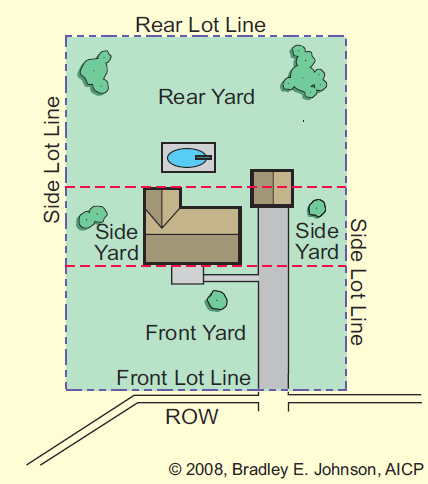
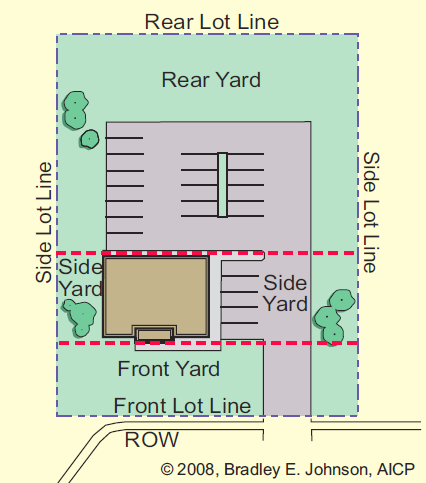
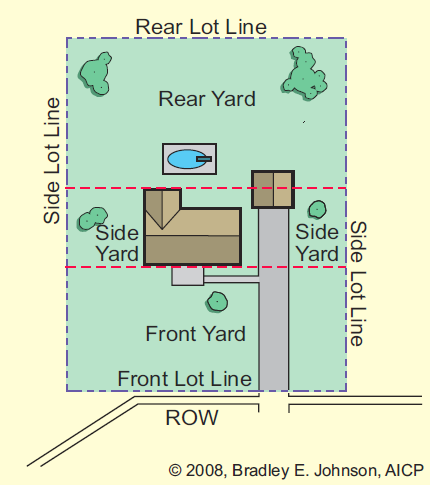
“Yard, front” means the horizontal space between the nearest foundation or structural appurtenance, or roof eave (whichever is closer) to the front lot line, extending to the side lines of the lot, and measured as the shortest distance from that foundation to the front lot line. (See graphic for “Yard.”) Corner lots have two front yards, each abutting a street right-of-way, pedestrian easement, or edge of pavement if no right-of-way or easement exists.
“Yard, rear” means the horizontal space between the nearest foundation or structural appurtenance of a building to a rear lot line and that rear lot line, extending to the side lines of the lot, and measured as the shortest distance from the foundation to the rear lot line. Corner lots do not have rear yards, rather they have two side yards. (See graphic for “Yard.”)
“Yard, side” means the horizontal space between the nearest foundation or structural appurtenance of a building to the side lot line. (See graphic for “Yard.”) [Ord. 1746-2023; Ord. 1286-2008. UDO § 11.02.]
18.08.270 Z definitions.
“Zone, floodplain” means a geographical area shown on a FHBM or FIRM that reflects the severity or type of flooding in the area.
“Zone, X” means the area where the flood hazard is less than that in the SFHA. Shaded X zones shown on recent FIRMs (B zones on older FIRMs) designate areas subject to inundation by the flood with a 0.2 percent chance of being equaled or exceeded (the 500-year flood). Unshaded X zones (C zones on older FIRMs) designate areas where the annual exceedance probability of flooding is less than 0.2 percent.
“Zoning Administrator” means the officer appointed by and/or delegated the responsibility for the administration of this title’s regulations by the Plan Commission. The term “Zoning Administrator” includes his/her authorized representatives. The designated Zoning Administrator is also called the Director of the Economic Development and Planning Department.
“Zoning district” means areas within the City of Angola for which uniform zoning regulations governing use, height, area, size, intensity of use of structures and land, and open spaces about structures, are established by this title. Districts are drawn on the official zoning map.
Zoning Map. See “Official zoning map.”
“Zoning map amendment” means the process used to change the current zoning district to another zoning district. [Ord. 1746-2023; Ord. 1286-2008. UDO § 11.02.]


